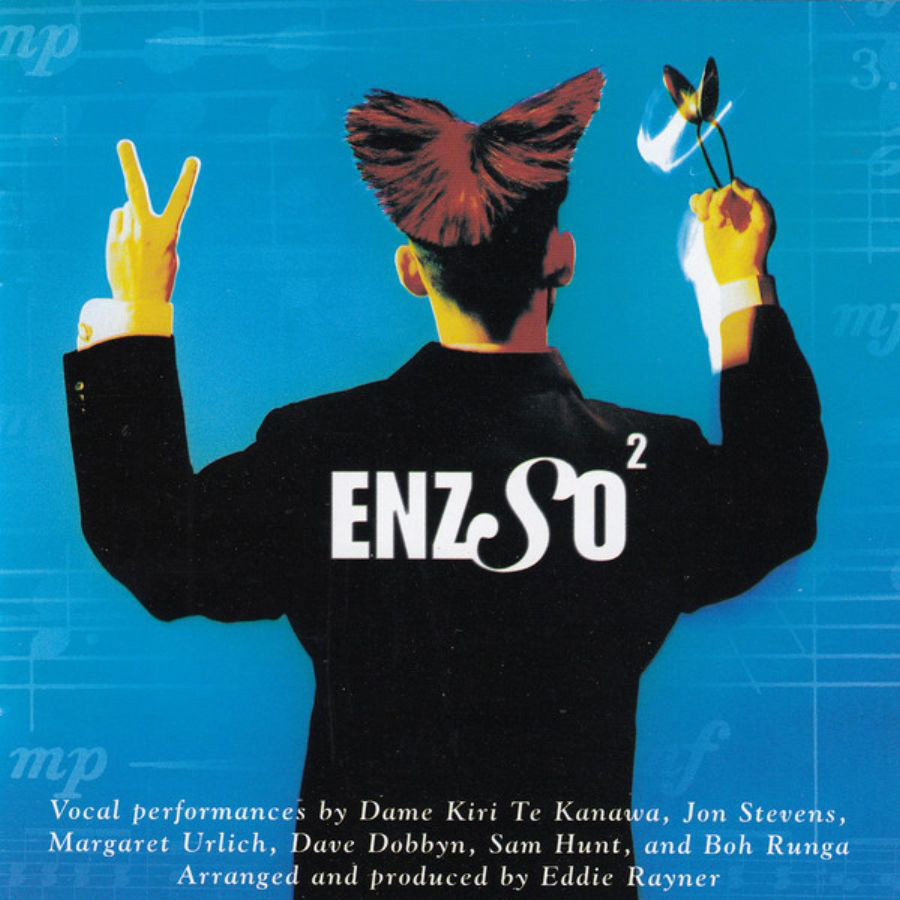
ENZSO2
I said in my review of the first ENZSO album that I’d love to hear more Split Enz songs translated into orchestral form. I’m glad I asked, and I’m even happier that Eddie Rayner agreed with everyone like me who wanted more. This is the second volume of the New Zealand Symphony Orchestra’s (hopefully ongoing) all-star tribute to the best rock band ever to emerge from the South Pacific. This time around, however, the Finn brothers do not make an appearance, and thus the list of guest vocalists is much more varied. Returning from ENZSO are the excellent Dave Dobbyn (taking over center stage for “The Devil You Know” and “Maybe”) and Sam Hunt (rambling his way through “Shark Attack”, probably my least favorite ENZSO translation). The major headliner on ENZSO2 is Dame Kiri Te Kanawa, who adeptly handles the soaring vocals Tim Finn originally sang in Bon Voyage. Margaret Urlich transforms “Semi-Detached” into an almost Tori-Amos-esque ballad (and, if there’s an ENZSO3, Urlich with her lovely voice gets my vote for a repeat appearance). The NZSO gets more chances to shine with instrumental renditions of “Six Months In A Leaky Boat” and “Frenzy”, in addition to the first track, a grand version of “Pioneer”, an instrumental from 1982’s “Time & Tide” which has always been a favorite of mine. In fact, if there’s anything I love about ENZSO2, it’s the selection of songs involved. Many of  them – “History Never Repeats”, “One Step Ahead”, “Maybe”, “Bon Voyage”, “Pioneer” – are among my all-time Enz favorites. It’s almost like Eddie Rayner was reading my mind when he picked the song list. Though it’s very hard to find (unless you check the Amazon.com link below, where I got my copy), I strongly recommend ENZSO2.
them – “History Never Repeats”, “One Step Ahead”, “Maybe”, “Bon Voyage”, “Pioneer” – are among my all-time Enz favorites. It’s almost like Eddie Rayner was reading my mind when he picked the song list. Though it’s very hard to find (unless you check the Amazon.com link below, where I got my copy), I strongly recommend ENZSO2.
- Pioneer (2:08)
- Six Months In A Leaky Boat (5:04)
- History Never Repeats (3:59)
- One Step Ahead (3:58)
- Devil You Know (7:02)
- Shark Attack (6:19)
- I Walk Away (5:07)
- Semi-Detached (5:54)
- Maybe (4:18)
- Bon Voyage (5:25)
- Frenzy (4:50)
Released by: Columbia/Sony Music NZ
Release date: 1998
Total running time: 54:06
Star Wars Episode I: The Phantom Menace
 Ladies and gentlemen, John Williams is back, and so is the universe of Star Wars. Many fans have been biting their nails over this element of the new movie, perhaps in fear that John Williams has lost his touch…but this film score proves that he has not. If anything, ever since I heard Williams’ music from Oliver Stone’s JFK and Nixon, I have been curious as to what the next Star Wars movie’s music would sound like – that is, if George Lucas ever got around to making the next movie.
Ladies and gentlemen, John Williams is back, and so is the universe of Star Wars. Many fans have been biting their nails over this element of the new movie, perhaps in fear that John Williams has lost his touch…but this film score proves that he has not. If anything, ever since I heard Williams’ music from Oliver Stone’s JFK and Nixon, I have been curious as to what the next Star Wars movie’s music would sound like – that is, if George Lucas ever got around to making the next movie.
In short…does the John Williams score for The Phantom Menace live up to the music from the original trilogy? Yes, it does. Given that this new film takes place a generation prior to the adventures of Luke Skywalker, in a complacent but basically pleasant galaxy that has yet to experience the horrors of Darth Vader or the Empire, the music is in a different vein. The constant military action in the original Star Wars trilogy demanded military music. But this “earlier” age in George Lucas’ fictional chronology, where the Jedi Knights are very much alive and well rather than legends of a bygone era, calls for more mysterious, and in some cases almost majestic music. Now, don’t become too alarmed – there is action music out the wazoo, and there are marches, and listening the The Phantom Menace soundtrack in the car may indeed give you the subliminal urge to dry to drive at hyperspace-worthy speeds.
To sum it up before we break down the entire CD track-by-track, John Williams knew what was expected of his music. The audience – and Lucas – wanted the immortal Star Wars/John Williams sound…as well as new surprises. And The Phantom Menace soundtrack does not disappoint in that regard.
Main Title / Arrival at Naboo: The familiar Star Wars signature theme opens the movie, instantly validating it as a real part of the storyline and turning us all into five-year-olds again, if only for a couple of minutes. Even before seeing the movie, I got chills from listening to this familiar tune segue into a new piece, a chunk of an adventure I had yet to experience. “The Arrival at Naboo” portion of this track follows the Star Wars main title tradition of opening up mysteriously and building up energy toward the end of the cue.
Duel of the Fates: This is the same piece which has been getting radio, MTV and VH-1 airplay. It’s this movie’s the equivalent of “The Imperial March” – a familiar theme which is woven throughout the fabric of the rest of the score, and at least one interview with George Lucas and John Williams has leaked out that this piece may underscore the final duel (we all know which one that will be) in the third prequel…so we can once again count on Lucas reverting back to the Return of the Jedi practice of occasionally tracking his new films with well-worn music. I have a love-hate relationship with “Duel of the Fates” – its primary choral motif is compelling and very memorable, but when the music slumps back into the low, menacing string rumble that seems to take forever to rebuild to the choral refrain, it seems as though the music has stopped short, never quite developing that motif further.
Anakin’s Theme: Wistful and nostalgic, “Anakin’s Theme” all but demands that we love Anakin Skywalker, for who but the most selfless and gentle child in the galaxy could merit such a nice theme tune? I’m a little mixed on this piece – it is very nice, don’t get me wrong, but I’m on the fence about the dubious merits of quoting “The Imperial March” from The Empire Strikes Back – a.k.a. Darth Vader’s theme – when virtually everyone knows that Anakin will become Vader in a matter of a few decades.
Jar Jar’s Introduction / The Swim To Otoh Gunga: Somewhere between Jawa music and Ewok music falls Jar Jar’s loping, comedic theme, very appropriate for his character. This theme literally dives into the flowing, mystical, and very choral music for the underwater trip to the Gungan city. I love this piece – the mysterious choral work reminds me a great deal of one of my all-time favorite instrumental pieces, Holst’s “Neptune” from The Planets. Williams provides music that really does flow over one like water, with appropriate tonal and atonal “undulations,” with an end result very much unlike anything in the original Star Wars trilogy. This is one of my favorite cues from the new movie.
The Sith Spacecraft / The Droid Battle: Opening with a classic terror-movie windup, this cue quickly jumps into a loud, threatening march, punctuated by a string quote of “Duel of the Fates”‘ primary motif.
The Trip to the Naboo Temple / An Audience with Boss Nass: After an opening crash, “The Trip to the Naboo Temple” moves forward with a low, menacing rhythm, worthy of an army of Battle Droids, but things lighten up considerably with some triumphant moments courtesy of our heroes. The music becomes, in turn, light-hearted and mysterious for “An Audience with Boss Nass” (the Gungan ruler voiced by Brian Blessed, who has guest-starred in virtually everything that has even been produced in Britain).
The Arrival on Tatooine / The Flag Parade: Opening up with an uncertain statement of Queen Amidala’s theme and another light-hearted hint of Jar Jar’s musical signature, things quickly get more serious. After a brief pause, a cue from later in the movie – a boisterous march marking the beginning of Jabba the Hutt’s Boonta Eve Podrace – kicks in. I rather like “The Flag Parade” – its combination of military bombast and oppressively heavy progressions gives it an air of a march in the Russian classical tradition.
He Is The Chosen One: A quiet and mysterious piece, this cue accompanies Qui-Gon’s growing suspicion that young Anakin Skywalker is destined for greater things. The Force theme, which was originally associated with Obi-Wan in the first movie’s score, leads into a sweeping flourish, which then decreases in intensity and leads to a restatement of “Anakin’s Theme”, followed by more uncertain “mystery” music. The cue closes out with a triumphant blast from the brass section.
Anakin Defeats Sebulba: This relentless action cue is also from the Podrace scene, right in the thick of the action. Things start out quietly, including another statement of the Force theme, which segues into something that sounds like an extension of “The Flag Parade” (which is placed later on the CD, but earlier in the film). Menacing “trouble” music and several quotations of “Anakin’s Theme” are heard. I’m sure this track will top several fans’ lists of their favorite Episode I musical moments, especially when the accompanying visuals are among the movie’s most dazzling sequences.
Watto’s Deal / Kids At Play: An almost atonal choral introduction leads into a very threatening-sounding passage which includes some ethnic-sounding reed elements. The music becomes only slightly less heavy with “Kids At Play”, which includes another choral moment, this one more mystic than menacing, though the music then proceeds to get much darker and more action-oriented.
Passage Through The Planet Core: Opening with more music reminiscent of Holst’s “Neptune”, things stay dark and murky for almost three minutes until a very nice statement of the Force theme. It seems that the latter 2/3 of this track must include music from other scenes in the movie, because “Anakin’s Theme” and more of Jar Jar’s amusing theme can be heard.
Panaka and the Queen’s Protectors: This swashbuckling number contains, aside from the opening seconds of the main theme, the only restatement of the Star Wars theme within the body of the movie – and you’ll miss it if you blink. Some almost Raiders of the Lost Ark-like moments punctuate the barrage of action music, until a quiet and percussive interruption intrudes, but the heroic antics quickly return, even more light-hearted than before.
Queen Amidala / The Naboo Palace: Unusually, given the title of this track, the music we first hear is very dark indeed, eventually leading to a rather romantic reading of “Anakin’s Theme”, followed by the return of the soaring fanfare heard toward the end of track 1. But this time, the fanfare is followed by some quiet, occasionally sinister music, culminating in a downbeat burst of orchestral fury.
The Droid Invasion / The Appearance of Darth Maul: A percussive intro similar to the opening seconds of track 4 is followed by an angry, oppressive march. But the real treat here is “The Appearance of Darth Maul”, which opens with several wavering, droning, falling notes, and then presents us with a rendition of what we previously knew as “The Emperor’s Theme” from Return of the Jedi, but given an even heavier treatment, with more prominent choral overtones than the previous film’s version of the same theme. It’s now likely that this isn’t the theme for Palpatine, but for the Sith Lords as a whole, since one of The Phantom Menace‘s inferences is that the Emperor, in the original trilogy, was the senior Sith Lord, fulfilling the role that Darth Sidious plays in this movie, pulling the strings as his younger apprentice did the footwork.
Qui-Gon’s Noble End: Possibly the best piece of music on the entire Episode I soundtrack, this number opens up at full throttle and keeps building the energy from there with a dark, militaristic battery of percussion. Of all the cues Williams composed for The Phantom Menace, it is this one which reminds me the most of his best work for the previous Star Wars trilogy. I would much rather have heard this released as a single than “Duel of the Fates”, since this cue takes the “Duel” theme and develops it fully. The silences are scary, and the thunderous full-blast moments are even scarier. Perhaps the biggest surprise is that it ends very quietly. This cue and “The Swim to Otoh Gunga” almost justify the purchase price of the album by themselves.
The High Council Meeting / Qui-Gon’s Funeral: Opening gently, and including a brief statement of Yoda’s theme from The Empire Strikes Back, followed by the only full statement of “The Imperial March” from the same movie (rather than the small hint of it built into “Anakin’s Theme”). This track gradually darkens as it segues, at the two-minute mark, into the funeral dirge for Liam Neeson’s fallen Jedi Knight, including a very effectively mournful statement of the Force theme and some beautiful choral moments, finally coming to a frighteningly uncertain end as the other Jedi contemplate the future of the boy that Qui-Gon brought into their fold before he fell.
Augie’s Great Municipal Band / End Title: I’ve already seen newsgroup and web site reviewers complaining about the two and a half minutes that open this cue, but I think it’s rather cute. A raucously brassy piece with children’s choir accents opens the proceedings, reminding one very much of Return of the Jedi‘s “Ewok Celebration”. Where the Ewok party jam sounded primitive and tribal, “Augie’s Great Municipal Band” comes across as almost Caribbean – the only thing missing is steel drums. The music reaches a brief climax and jumps into the traditional Star Wars end title suite, which adds a small twist to the main theme and then cuts off abruptly just before a “Duel of the Fates” reprise. After the “Duel” reprise ends, we slide into “Anakin’s Theme”, which leads to the biggest contrast to the  original trilogy’s end title suites. Instead of crashing into a triumphant flourish as the three original movies did, this suite closes with a quietly menacing reiteration of the “Imperial March” quote from “Anakin’s Theme”. In retrospect, The Phantom Menace‘s musical conclusion is much more like that of Williams’ music for JFK or Nixon.
original trilogy’s end title suites. Instead of crashing into a triumphant flourish as the three original movies did, this suite closes with a quietly menacing reiteration of the “Imperial March” quote from “Anakin’s Theme”. In retrospect, The Phantom Menace‘s musical conclusion is much more like that of Williams’ music for JFK or Nixon.
- Main Title / Arrival at Naboo (2:55)
- Duel of the Fates (4:14)
- Anakin’s Theme (3:09)
- Jar Jar’s Introduction / The Swim To Otoh Gunga (5:07)
- The Sith Spacecraft / The Droid Battle (2:37)
- The Trip to the Naboo Temple / An Audience with Boss Nass (4:07)
- The Arrival on Tatooine / The Flag Parade (4:54)
- He Is The Chosen One (3:53)
- Anakin Defeats Sebulba (4:24)
- Watto’s Deal / Kids At Play (4:57)
- Passage Through The Planet Core (4:58)
- Panaka and the Queen’s Protectors (3:24)
- Queen Amidala / The Naboo Palace (4:51)
- The Droid Invasion / The Appearance of Darth Maul (5:14)
- Qui-Gon’s Noble End (3:48)
- The High Council Meeting / Qui-Gon’s Funeral (3:09)
- Augie’s Great Municipal Band / End Title (9:37)
Released by: Sony Classical
Release date: 1999
Total running time: 74:15
Ben Folds Five – Unauthorized Biography Of Reinhold Messner
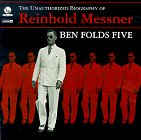 The fourth album from Folds, Sledge and Jessee – actually, technically only their third album since Naked Baby Photos was more of a B-side/outtake compilation slapped together by the band’s first label to capitalize on their major-label success – ventures into more adventurous and mature musical territory that one might expect, given the alternative-rock pedigree that put them on the map. Reinhold Messner introduces a more introspective and pensive side to the band, and also explores the musical possibilities of overstepping their well-known piano/fuzz bass/drum combo. Small string and brass ensembles liven up several tracks, notably “Don’t Change Your Plans”, which sounds very much like a good, smooth early 70s Chicago tune in its instrumental break. The voice and the lyrics are still true to Folds’ past work, but aside from the opening track and a couple of amusing upbeat songs halfway through the album, the music is slower and more intricate – even better than, say, “Brick” (which was no slouch). There are also indications – namely the hilarious yet strangely touching track “Your Most Valuable Possession”, which consists of a jazzy musical backing under an actual message left on Folds’ answering machine by his father – that Folds’
The fourth album from Folds, Sledge and Jessee – actually, technically only their third album since Naked Baby Photos was more of a B-side/outtake compilation slapped together by the band’s first label to capitalize on their major-label success – ventures into more adventurous and mature musical territory that one might expect, given the alternative-rock pedigree that put them on the map. Reinhold Messner introduces a more introspective and pensive side to the band, and also explores the musical possibilities of overstepping their well-known piano/fuzz bass/drum combo. Small string and brass ensembles liven up several tracks, notably “Don’t Change Your Plans”, which sounds very much like a good, smooth early 70s Chicago tune in its instrumental break. The voice and the lyrics are still true to Folds’ past work, but aside from the opening track and a couple of amusing upbeat songs halfway through the album, the music is slower and more intricate – even better than, say, “Brick” (which was no slouch). There are also indications – namely the hilarious yet strangely touching track “Your Most Valuable Possession”, which consists of a jazzy musical backing under an actual message left on Folds’ answering machine by his father – that Folds’  experimental side project Fear Of Pop was a necessary testing ground for some very interesting possible future directions for Ben Folds Five. I have no reservations about nominating Reinhold Messner and Jason Falkner’s Can You Still Feel? as the best rock/pop albums of the first half of 1999. Highly recommended.
experimental side project Fear Of Pop was a necessary testing ground for some very interesting possible future directions for Ben Folds Five. I have no reservations about nominating Reinhold Messner and Jason Falkner’s Can You Still Feel? as the best rock/pop albums of the first half of 1999. Highly recommended.
- Narcolepsy (5:24)
- Don’t Change Your Plans (5:11)
- Mess (4:03)
- Magic (4:02)
- Hospital Song (2:05)
- Army (3:25)
- Your Redneck Past (3:43)
- Your Most Valuable Possession (1:55)
- Regrets (4:07)
- Jane (2:42)
- Lullabye (3:53)
Released by: Sony 550
Release date: 1999
Total running time: 40:37
Umajets – Swollen And Tender
 The second album from Rob Aldridge and Tim Smith, the latter of whom was a one-time member of Jellyfish, turns out to be a departure from the duo’s previous work. Their debut album Demolotion was a trippy but rockin’ mix of catchy songs, often in the best tradition of Jellyfish, but that style has vanished for their second outing, which largely consists of acoustic ballads – or at least it seems to. Truth be told, only half of the album fits that mode, but the preponderance of such material had the effect of tricking my mind into thinking that the entire album was pretty sleepy. I don’t mind acoustic ballads, or even entire albums of them, but that’s just not what I had in mind when I shelled out money for an Umajets CD. That’s not to say that there isn’t good material on here, though – my favorite number has to be the jaunty, galloping “Hang Ten”, which seems to concern the dying thoughts of a surfer who finally encounters a wave that’s more than he can
The second album from Rob Aldridge and Tim Smith, the latter of whom was a one-time member of Jellyfish, turns out to be a departure from the duo’s previous work. Their debut album Demolotion was a trippy but rockin’ mix of catchy songs, often in the best tradition of Jellyfish, but that style has vanished for their second outing, which largely consists of acoustic ballads – or at least it seems to. Truth be told, only half of the album fits that mode, but the preponderance of such material had the effect of tricking my mind into thinking that the entire album was pretty sleepy. I don’t mind acoustic ballads, or even entire albums of them, but that’s just not what I had in mind when I shelled out money for an Umajets CD. That’s not to say that there isn’t good material on here, though – my favorite number has to be the jaunty, galloping “Hang Ten”, which seems to concern the dying thoughts of a surfer who finally encounters a wave that’s more than he can  handle. There’s also a gentle cover of Thomas Dolby’s “Screen Kiss”, with vocals that sound very much like Howard Jones (how’s that for a bizarre mix of 80’s new wave icons?). So, to recap, there is good stuff on the second Umajets CD, but the band sounds vastly different this time than they did the first time around – there’s nothing here to compare to “Daphne’s Disease” or “Fly”.
handle. There’s also a gentle cover of Thomas Dolby’s “Screen Kiss”, with vocals that sound very much like Howard Jones (how’s that for a bizarre mix of 80’s new wave icons?). So, to recap, there is good stuff on the second Umajets CD, but the band sounds vastly different this time than they did the first time around – there’s nothing here to compare to “Daphne’s Disease” or “Fly”.
- When I Wake Up (3:54)
- On The Moon (3:05)
- Screen Kiss (5:08)
- Mr. Combination (3:37)
- Boxes (3:11)
- Butterfly Mind (4:25)
- Life Moves On (5:06)
- Inside (4:25)
- Congratulations (2:56)
- Hang Ten (2:49)
- Long Way Home (3:25)
Released by: Clearspot
Release date: 1999
Total running time: 42:03
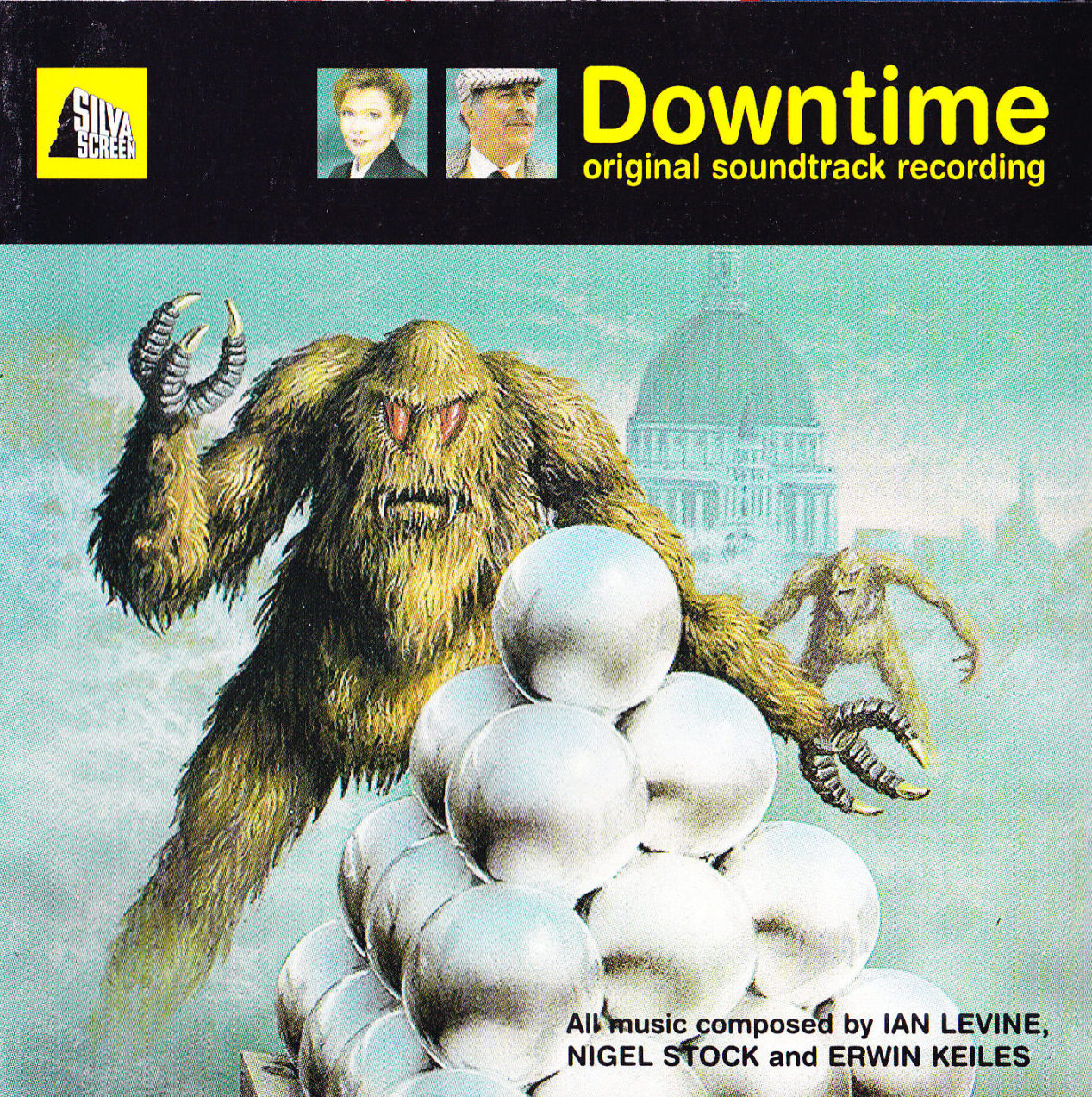
Downtime
At least two years after its initial release (and having passed on it then), I spotted this slightly obscure collection of music from a Doctor Who video spinoff (like Shakedown: Return of the Sontarans) and thought I’d give it a try.
No one ever said that every Doctor Who-related CD release was worthwhile. While there were some interesting ideas in the production of this soundtrack – not the least of which was the inclusion of actual stringed instruments, as opposed to the synth-strings which have served Mark Ayres and previous Who composers so well – it just seemed that there was an overabundance of production concepts and talent, and a lack of any clear direction in a musical sense. The main titles and the “Confrontation” track are two of the highlights, and frankly, it’s not difficult to stand out above the remainder of the largely forgettable and occasionally irritating music that fills out this CD.
There are some ridiculously short cues which add little to the overall musical landscape, and there are also at least one or two tracks which contain annoyingly shrill synthesizer sounds which create that painful harmonic buzz that threatens to summon every dog in your neighborhood at any moment. And perhaps the greatest insult is that, for a score which purports to contain real acoustic instruments, there are precious few of them to be heard. There’s a very nice suspense motif which sounds like it was played on viola, heard mainly in the first half of the score, and a few other examples of real stringed instruments, but for the most part Downtime is saddled with a helping of synth strings. Now, in the past, I’ve praised other Doctor Who composers and musicians for their innovative use of synth strings and string samples – more often than not, they were forced to fall back on synths for simple budgetary reasons. But to put a real stringed instrument back-to-back with a synth patch…bad idea. The contrast is immediately apparent, and the result makes me wonder if  the music budget ran out on this production as well.
the music budget ran out on this production as well.
Unless you’re a Doctor Who mega-completist (which obviously I am), I can’t honestly recommend this soundtrack. Even if you saw and liked the video, the soundtrack is hardly worth the effort to try to listen to the whole thing without dialogue and special effects.
- Introduction: Det Sen Monastery and Title Sequence (4:27)
- Astral Plane (0:56)
- Confrontation (2:04)
- Eerie (0:37)
- First Chase (0:36)
- Second Chase (0:15)
- Truth (0:34)
- Chase / Astral Plane (3:36)
- Brigadier’s Lost Memory (2:43)
- Intelligence (1:21)
- Message Understood (0:17)
- He Feel (1:14)
- Hallucination (0:16)
- Astral Plane (1:47)
- Travers (0:16)
- I’m Still Alive (1:40)
- Danny Was Right (0:32)
- Double Cross (1:23)
- Sting (0:06)
- Build-Up (1:02)
- Apparition (0:20)
- The Stranger (0:51)
- Realisation (1:46)
- Family / Yeti Themes (4:16)
- Approach (1:04)
- Single Sting (0:04)
- The Lift (0:08)
- Webs (0:05)
- Attack (0:46)
- Yeti March (2:12)
- Climax (0:27)
- Victoria (6:18)
- Family Theme (0:20)
- End Credits (3:10)
Released by: Silva Screen
Release date: 1995
Total running time: 48:18

Jason Falkner – Can You Still Feel?
 It took me a while to warm to the second solo project by Jellyfish’s original guitarist, and after a week or so of listening to it, the thought has occurred that perhaps I set my expectations too high for it as well. Opening up with a very brief, low-key opening, the album jumps into high gear with Author Unknown (which actually borrows its title from Jason’s first album). Again, the emphasis seems to be on 70’s-style power pop, though the production values here skew a little more Beatlesque and groovy than the first album did. My favorites – so far – include “Revelation”, the very cool “Holiday” (which also has some of the best lyrics I’ve heard anyone write in a long time), and the heavy “I Already Know”. I can’t put a finger on why the album as a whole doesn’t grab me like its predecessor did – some of its songs are certainly worthy of
It took me a while to warm to the second solo project by Jellyfish’s original guitarist, and after a week or so of listening to it, the thought has occurred that perhaps I set my expectations too high for it as well. Opening up with a very brief, low-key opening, the album jumps into high gear with Author Unknown (which actually borrows its title from Jason’s first album). Again, the emphasis seems to be on 70’s-style power pop, though the production values here skew a little more Beatlesque and groovy than the first album did. My favorites – so far – include “Revelation”, the very cool “Holiday” (which also has some of the best lyrics I’ve heard anyone write in a long time), and the heavy “I Already Know”. I can’t put a finger on why the album as a whole doesn’t grab me like its predecessor did – some of its songs are certainly worthy of  the honor – but it could be the leaning toward obviously-dated 70’s production techniques and keyboards, even though I tend to enjoy a lot of music that really is from that period. But in retrospect, it took me a long time to warm to some of the songs on Jason’s first album which now rank as my favorites, so it may be a month or three before the real brilliance behind Can You Still Feel? hits me.
the honor – but it could be the leaning toward obviously-dated 70’s production techniques and keyboards, even though I tend to enjoy a lot of music that really is from that period. But in retrospect, it took me a long time to warm to some of the songs on Jason’s first album which now rank as my favorites, so it may be a month or three before the real brilliance behind Can You Still Feel? hits me.
- The Invitation (0:26)
- Author Unknown (3:32)
- Revelation (5:45)
- My Lucky Day (3:25)
- Holiday (3:59)
- Eloquence (3:42)
- I Already Know (4:26)
- See You Again (5:06)
- Honey (4:15)
- The Plan (4:45)
- All God’s Creatures (2:54)
- Good Night, Sweet Night (4:10)
Released by: Elektra
Release date: 1999
Total running time: 46:27
Electric Light Orchestra – The Night The Light Went On…
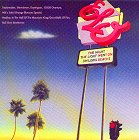 Somewhere between obscurity and fame – i.e. between their third and fourth albums – ELO recorded this California gig which is one of the most energetic and unusual performances the band ever put on. If the track list for this album looks unusual, that’s because, aside from “Roll Over Beethoven”, it’s the only evidence on record that ELO was a decent cover band prior to their ascension to superstardom. Jeff Lynne’s influences – the Beatles and Jerry Lee Lewis (what a combo!) – receive an homage from the respective (and, I might add, very good) covers of “Daytripper” and “Great Balls Of Fire”. Not used to the thought of him singing other people’s material, I was surprised at how well Lynne could carry off Jerry Lee Lewis’ vocal style. And there are three outstanding instrumentals – one, “Daybreaker”, is an ELO original from On The Third Day; another, “Mik’s Solo / Orange Blossom Special”, runs the gamut from classical to hoedown in a matter of a few hilarious minutes (courtesy of ELO’s resident virtuoso
Somewhere between obscurity and fame – i.e. between their third and fourth albums – ELO recorded this California gig which is one of the most energetic and unusual performances the band ever put on. If the track list for this album looks unusual, that’s because, aside from “Roll Over Beethoven”, it’s the only evidence on record that ELO was a decent cover band prior to their ascension to superstardom. Jeff Lynne’s influences – the Beatles and Jerry Lee Lewis (what a combo!) – receive an homage from the respective (and, I might add, very good) covers of “Daytripper” and “Great Balls Of Fire”. Not used to the thought of him singing other people’s material, I was surprised at how well Lynne could carry off Jerry Lee Lewis’ vocal style. And there are three outstanding instrumentals – one, “Daybreaker”, is an ELO original from On The Third Day; another, “Mik’s Solo / Orange Blossom Special”, runs the gamut from classical to hoedown in a matter of a few hilarious minutes (courtesy of ELO’s resident virtuoso  Mik Kaminski); and the third, a heavy metal cover of Grieg’s “In The Hall of the Mountain King” (also recorded on Third Day), segues abruptly into the aforementioned Jerry Lee Lewis rocker. This ranks up there with the Winterland CD and ELO Part II’s One Night as yet another example that, at least some of the time, ELO was a damn fine live band.
Mik Kaminski); and the third, a heavy metal cover of Grieg’s “In The Hall of the Mountain King” (also recorded on Third Day), segues abruptly into the aforementioned Jerry Lee Lewis rocker. This ranks up there with the Winterland CD and ELO Part II’s One Night as yet another example that, at least some of the time, ELO was a damn fine live band.
- Daybreaker (5:36)
- Showdown (6:54)
- Daytripper (6:40)
- 10538 Overture (5:44)
- Mik’s Solo / Orange Blossom Special (2:28)
- In the Halls of the Mountain King / Great Balls of Fire (8:35)
- Roll Over Beethoven (4:25)
Released by: Epic / Sony UK
Release date: 1974 (reissued on CD in 1997)
Total running time: 40:25
Babylon 5: Sleeping In Light
 The hauntingly tragic music from the final hour of Babylon 5 is easily the jewel in Chris Franke’s crown over the past six years. There is almost nothing that ties this episode’s music to the rest of Babylon 5, with the exception of a couple of cues which appeared in the two episodes preceding Sleeping In Light. Even the theme is a treat, since the unique titles in Sleeping In Light were not only completely different from any other main theme in the show’s history, but didn’t appear until the end of the episode, giving a “bookend” effect. The music’s success lies with the Berlin Symphonic Film Orchestra’s string sections more than usual, giving the tragically touching episode’s story a very human musical treatment. Though Franke has achieved great intensity in the past, that intensity has
The hauntingly tragic music from the final hour of Babylon 5 is easily the jewel in Chris Franke’s crown over the past six years. There is almost nothing that ties this episode’s music to the rest of Babylon 5, with the exception of a couple of cues which appeared in the two episodes preceding Sleeping In Light. Even the theme is a treat, since the unique titles in Sleeping In Light were not only completely different from any other main theme in the show’s history, but didn’t appear until the end of the episode, giving a “bookend” effect. The music’s success lies with the Berlin Symphonic Film Orchestra’s string sections more than usual, giving the tragically touching episode’s story a very human musical treatment. Though Franke has achieved great intensity in the past, that intensity has  usually been of the fiery, warlike variety, whereas Sleeping In Light relies on a purely emotional intensity and genuine acoustics. There’s much more subtlety in the music than really got through in the televised sound mix, and anyone who watched the episode and thought, “Wow, the music’s really good this week!” should give this CD a listen – even if you thought it was good, it’s better than you think.
usually been of the fiery, warlike variety, whereas Sleeping In Light relies on a purely emotional intensity and genuine acoustics. There’s much more subtlety in the music than really got through in the televised sound mix, and anyone who watched the episode and thought, “Wow, the music’s really good this week!” should give this CD a listen – even if you thought it was good, it’s better than you think.
- Act One (2:11)
- Sheridan’s Dream (1:36)
- Sunrise (0:45)
- Act Two (2:51)
- I Have a Message (1:57)
- Come To Minbar (0:53)
- Act Three (7:11)
- How Long Do I Have? (1:27)
- Old Friends (2:26)
- I Am Going To Miss Him (1:43)
- Sheridan’s Last Wish (1:39)
- Act Four (5:05)
- It’s Sunday On Earth (0:27)
- Goodnight, My Love (2:00)
- Only Memory (1:22)
- Computer, Set Course (1:24)
- Act Five (5:39)
- The White Light (1:16)
- Echoes of the Past (1:19)
- Dying Station (2:32)
- Delenn’s Sunrise (0:32)
- End Title (1:44)
Released by: Sonic Images
Release date: 1999
Total running time: 24:40
Sixpence None The Richer
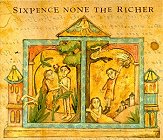 Yep, it’s the “Kiss Me” band. Thanks to heavy MTV rotation of a song which was played on Dawson’s Creek, Sixpence None The Richer’s 1997 album suddenly wound up being a hot commodity – which is a good thing, since their self-titled CD didn’t deserve the trip into obscurity that it initially took.
Yep, it’s the “Kiss Me” band. Thanks to heavy MTV rotation of a song which was played on Dawson’s Creek, Sixpence None The Richer’s 1997 album suddenly wound up being a hot commodity – which is a good thing, since their self-titled CD didn’t deserve the trip into obscurity that it initially took.
The real commodity that keeps Sixpence afloat is guitarist/cellist Matt Slocum’s accessible songwriting. Though the songs on this CD frequently have complex and interesting arrangements, they’re never so thick with instrumentation that you can’t get to the heart of the song. Lead singer Leigh Nash has an appealing voice, always sounding very young – and in some cases, that’s a good thing. “Kiss Me”, though it has now gone from obscurity to having spent a year being overexposed on radio and MTV, is a sweet, innocent song, and just wouldn’t have worked without Nash’s youthful vocal style.
 Oft-overlooked album tracks include “We Have Forgotten” and my personal favorite, “Sister, Mother”. And speaking of well-worn radio staples, “There She Goes” is included on this CD, though in most early pressings it’s an unlisted track. More recent pressings have added that song – which became the album’s next big single – to the track list.
Oft-overlooked album tracks include “We Have Forgotten” and my personal favorite, “Sister, Mother”. And speaking of well-worn radio staples, “There She Goes” is included on this CD, though in most early pressings it’s an unlisted track. More recent pressings have added that song – which became the album’s next big single – to the track list.
- We Have Forgotten (5:07)
- Anything (4:50)
- The Waiting Room (5:15)
- Kiss Me (3:30)
- Easy To Ignore (3:53)
- Peudo Escribir (3:46)
- I Can’t Catch You (4:12)
- The Lines Of My Earth (4:26)
- Sister, Mother (3:06)
- I Won’t Stay Long (2:15)
- Love (3:56)
- Moving On (3:56)
- There She Goes (3:13)
Released by: Squint
Release date: 1997
Total running time: 50:53
Babylon 5: Objects at Rest
 The last Babylon 5 episode produced, this episode dealt primarily with the scattering of the show’s cast of characters. As such, there aren’t many action cues; the only fast-paced material surrounds Lennier’s betrayal of Sheridan halfway through the show. But in many ways, the more reflective and quiet music on this disc is much more interesting than any action cue that could’ve been jammed into the show sideways. Objects At Rest is very closely linked, thematically, to the final episode aired, Sleeping In Light. And those similarities in tone extend to the music. Sheridan’s salute to the new crew of Babylon 5 appropriately echoes the music heard over the destruction of the station in Sleeping In Light, and the final cue before the end credits of Objects At Rest serves as a very effective musical prologue to the next episode. Other moments worth listening for: Franklin’s
The last Babylon 5 episode produced, this episode dealt primarily with the scattering of the show’s cast of characters. As such, there aren’t many action cues; the only fast-paced material surrounds Lennier’s betrayal of Sheridan halfway through the show. But in many ways, the more reflective and quiet music on this disc is much more interesting than any action cue that could’ve been jammed into the show sideways. Objects At Rest is very closely linked, thematically, to the final episode aired, Sleeping In Light. And those similarities in tone extend to the music. Sheridan’s salute to the new crew of Babylon 5 appropriately echoes the music heard over the destruction of the station in Sleeping In Light, and the final cue before the end credits of Objects At Rest serves as a very effective musical prologue to the next episode. Other moments worth listening for: Franklin’s  departure (given a rather lonely, melancholy sound instead of playing up the emotion), Sheridan’s recorded message to his unborn child, and especially the unsettling music heard as Londo – now Emperor of the Centauri – communicates with his new masters as he leaves Minbar. You’ll get much more out of Objects At Rest by listening to it back-to-back with Sleeping In Light.
departure (given a rather lonely, melancholy sound instead of playing up the emotion), Sheridan’s recorded message to his unborn child, and especially the unsettling music heard as Londo – now Emperor of the Centauri – communicates with his new masters as he leaves Minbar. You’ll get much more out of Objects At Rest by listening to it back-to-back with Sleeping In Light.
- Teaser (3:44)
- Opening "Objects At Rest" (0:31)
- Sheridan and Lochley Say Goodbye (0:37)
- Message from G’Kar (1:08)
- Babylon 5 season five main title (1:30)
- Act One (3:51)
- G’Kar’s Emotional Address (1:29)
- Franklin Is About To Leave (0:43)
- Lennier’s Surprise Visit (0:27)
- Garibaldi On Mars (0:39)
- Garibaldi’s Idea / Franklin’s Goodbye (0:55)
- Act Two (6:39)
- Rumors (0:39)
- The Word "Goodbye" (2:35)
- One Last Look At The Place (2:33)
- Danger and Betrayal (0:53)
- Act Three (4:14)
- Desperation (2:00)
- Minbar – The New Home (2:15)
- Act Four (4:08)
- Delenn and Londo’s Moment (1:05)
- Londo’s Sealed Gift (0:34)
- The Modesty (1:21)
- Dark Secrets of Fate (1:26)
- Act Five (5:17)
- Sheridan’s Message (1:33)
- Talking To The Unborn (2:14)
- Delenn and Sheridan (1:00)
- End Title (0:36)
Released by: Sonic Images
Release date: 1999
Total running time: 27:52
She’s The One – music by Tom Petty & the Heartbreakers
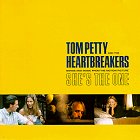 An unusual venture for Petty and company, this album consists of music from a 1996 movie which was little more than an attempt to launch Jennifer Aniston of Friends fame onto the big screen. But, perhaps a little like the soundtrack from 1980’s Xanadu, this is a case where the soundtrack was the only notable thing about the movie.
An unusual venture for Petty and company, this album consists of music from a 1996 movie which was little more than an attempt to launch Jennifer Aniston of Friends fame onto the big screen. But, perhaps a little like the soundtrack from 1980’s Xanadu, this is a case where the soundtrack was the only notable thing about the movie.
I got this CD largely because I liked the single from it, “Walls” (which features a very unique background vocal assist from Lindsey Buckingham, the first trace of him I’ve heard since his 1992 Out Of The Cradle solo album). I was also curious as to why Walls didn’t appear on Petty’s 1998 greatest hits album, but the most likely explanation for that is the same as why ELO’s hits from the aforementioned Xanadu rarely, if ever, appear on their compilations – the soundtrack was released by a different label. Even after listening to the entire CD, “Walls” remains my favorite track, mainly because Buckingham’s presence and his signature stereo vocals (he’s singing something different in each of the left and right channels) give it a different feel from most other Petty songs.
Tracks 2 through 5 offer the standard southern rock that we’ve come to expect from the Heartbreakers, with “Zero From Outer Space” delving into very Dylanesque territory with Petty’s half-spoken, half-sung vocals. Things become more interesting with “Hope You Never”, which sounds more like some of the material from Full Moon Fever, Petty’s 1989 collaboration with producer Jeff Lynne. The following number, “Asshole” (which, from the title, one would most likely suspect to be another fast-paced country fried rock tune), has almost Beatlesque lyrics and instrumentation, with some excellent harmonies. Another  standout track, a short instrumental version of “Walls” listed as “Hope On Board”, precedes a second, more acoustic (and Buckingham-less) mix of “Walls”.
standout track, a short instrumental version of “Walls” listed as “Hope On Board”, precedes a second, more acoustic (and Buckingham-less) mix of “Walls”.
Overall, a good effort from Petty and friends to liven up a movie conceived and bred in corporate Hollywood. The music would probably be better remembered if its bad-idea-from-the-start film namesake hadn’t bombed.
- Walls – Circus version (4:25)
- Grew Up Fast (5:10)
- Zero From Outer Space (3:08)
- Climb That Hill (3:58)
- Change The Locks (4:57)
- Angel Dream – no. 4 version (2:27)
- Hope You Never (3:03)
- Asshole (3:12)
- Supernatural Radio (5:22)
- California (2:40)
- Hope On Board (1:18)
- Walls – no. 3 version (3:04)
- Angel Dream – no. 2 version (2:27)
- Hung Up and Overdue (5:49)
- Airport (0:58)
Released by: Warner Bros.
Release date: 1996
Total running time: 51:58
Babylon 5: Falling Toward Apotheosis
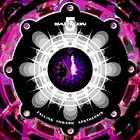 Ahh, yes! Sonic Images does actually listen to their buying public. The label has, for some time, had an e-mail address set up to take requests from Babylon 5 fans to determine which episode soundtracks will appear next, and Falling Toward Apotheosis – a critical early season 4 favorite of mine – has been on my want list for a long time. A fair-sized snippet of one scene appeared on the second B5 suite compilation, but ended before some of the best music in the episode, accompanying the (literally) thunderous exit of the Vorlon ship whose master is being ambushed inside the
Ahh, yes! Sonic Images does actually listen to their buying public. The label has, for some time, had an e-mail address set up to take requests from Babylon 5 fans to determine which episode soundtracks will appear next, and Falling Toward Apotheosis – a critical early season 4 favorite of mine – has been on my want list for a long time. A fair-sized snippet of one scene appeared on the second B5 suite compilation, but ended before some of the best music in the episode, accompanying the (literally) thunderous exit of the Vorlon ship whose master is being ambushed inside the  station. There’s at least one cue, “The Vorlon Strikes Back”, which I don’t even recall hearing in the show – I even looked at it on tape again and couldn’t find it – so perhaps we have a first for the Babylon 5 episodics, a “we didn’t use it in the final show, but we’re putting it on CD anyway” cue of the sort which has long been a fixture on Star Trek: The Next Generation soundtracks. Exciting stuff!
station. There’s at least one cue, “The Vorlon Strikes Back”, which I don’t even recall hearing in the show – I even looked at it on tape again and couldn’t find it – so perhaps we have a first for the Babylon 5 episodics, a “we didn’t use it in the final show, but we’re putting it on CD anyway” cue of the sort which has long been a fixture on Star Trek: The Next Generation soundtracks. Exciting stuff!
- Teaser (4:26)
- Our Greatest Enemy Is Fear (1:32)
- Main Title (1:27)
- Act One (6:56)
- Garibaldi Reviews Videos (0:35)
- Garibaldi Is Concerned (0:43)
- Cartagia’s Madness (0:45)
- Act Two (4:36)
- Garibaldi’s Physical Exam (0:29)
- Interplanetary Emergency (1:35)
- A Reason To Come Back (1:13)
- Plan To Attack Kosh 2 (1:41)
- Act Three (5:14)
- The Team Enters Kosh’s Quarters (1:15)
- The Vorlon Fights Back (0:25)
- Team Retreat (0:48)
- Fighting Evil (3:05)
- Act Four (4:00)
- Light Against Darkness (3:23)
- G’kar’s Execution Scheduled (0:36)
- Act Five (4:55)
- Gathering of the Fleet (0:56)
- The Engagement Ring (1:05)
- G’kar Loses His Eye (1:48)
- End Title (0:37)
Released by: Sonic Images
Release date: 1999
Total running time: 23:03
Merril Bainbridge – Between The Days
 After hearing her surprisingly promising, if somewhat formulaic, first album, I was a little less reluctant to pick up Merril Bainbridge’s second collection. I found myself disturbed when that second album turned out to be even more formulaic than the first, probably thanks to the self-appointed, one-person-focus-groups of the music world, record company executives. The sound of Merril Bainbridge’s second album is very much dictated by the sound of the first, and it probably comes as no surprise that the chief influence seems to be the successful single “Mouth”. There are, however, at least two very impressive tracks on this CD, both of which highlight Merril’s vocal prowess and some very catchy and unusual rhythmic patterns. “Lonely”,
After hearing her surprisingly promising, if somewhat formulaic, first album, I was a little less reluctant to pick up Merril Bainbridge’s second collection. I found myself disturbed when that second album turned out to be even more formulaic than the first, probably thanks to the self-appointed, one-person-focus-groups of the music world, record company executives. The sound of Merril Bainbridge’s second album is very much dictated by the sound of the first, and it probably comes as no surprise that the chief influence seems to be the successful single “Mouth”. There are, however, at least two very impressive tracks on this CD, both of which highlight Merril’s vocal prowess and some very catchy and unusual rhythmic patterns. “Lonely”,  a bouncy reggae-influenced tune (and the album’s first single), and “Stars Collide”, an ethereal ballad which also displays some reggae chops, are my favorites, and I think that a third album would definitely benefit from more stylistic experimentation along these lines, rather than slavishly following what has gone before. I give this album a cautious recommendation.
a bouncy reggae-influenced tune (and the album’s first single), and “Stars Collide”, an ethereal ballad which also displays some reggae chops, are my favorites, and I think that a third album would definitely benefit from more stylistic experimentation along these lines, rather than slavishly following what has gone before. I give this album a cautious recommendation.
- Between the Days (3:40)
- Lonely (3:34)
- Goodbye To Day (4:05)
- Stars Collide (4:19)
- Walk On Fire (3:59)
- Hello (4:02)
- Blindfolded (4:39)
- Love and Terror (3:54)
- When You Call My Name (4:48)
- Big Machine (4:01)
Released by: Universal
Release date: 1998
Total running time: 41:03
Merril Bainbridge – In The Garden
 This one really caught me off guard. Like Alanis Morissette’s album, I resisted buying this for a long time because it’s just not typical for me to gravitate toward something that’s getting current radio airplay. I don’t even know what it was about Merril’s weird single “Mouth” that did it for me, but I reluctantly picked up the album and found that she never quite sounds the same way twice. Bainbridge emerges as an effective pop-lite vocalist, sounding a lot like Olivia Newton-John did in her heyday in the 1970s. But even though she comes across initially as yet another cute, pre-packaged artist put together by a producer, some of her vocals really are quite effective, and even some of the backing tracks are above par. The real standout on this album is “Power Of One”, an absolutely gorgeous ballad with excellent lyrics and production. It’s a very
This one really caught me off guard. Like Alanis Morissette’s album, I resisted buying this for a long time because it’s just not typical for me to gravitate toward something that’s getting current radio airplay. I don’t even know what it was about Merril’s weird single “Mouth” that did it for me, but I reluctantly picked up the album and found that she never quite sounds the same way twice. Bainbridge emerges as an effective pop-lite vocalist, sounding a lot like Olivia Newton-John did in her heyday in the 1970s. But even though she comes across initially as yet another cute, pre-packaged artist put together by a producer, some of her vocals really are quite effective, and even some of the backing tracks are above par. The real standout on this album is “Power Of One”, an absolutely gorgeous ballad with excellent lyrics and production. It’s a very  nice track that promises much, even though her sophomore outing dropped the ball on the potential of her treatment of slower songs. She may never amass more than a small cult following in the U.S., but I have a feeling that – despite the folly of releasing the goofy “Under The Water” as the second single from this album – we haven’t heard the last of Merril Bainbridge yet.
nice track that promises much, even though her sophomore outing dropped the ball on the potential of her treatment of slower songs. She may never amass more than a small cult following in the U.S., but I have a feeling that – despite the folly of releasing the goofy “Under The Water” as the second single from this album – we haven’t heard the last of Merril Bainbridge yet.
- Garden In My Room (4:32)
- Under The Water (4:13)
- Miss You (3:04)
- Mouth (3:26)
- Julie (3:56)
- Song For Neen (2:41)
- Sleeping Dogs (3:28)
- Reasons Why (2:57)
- Spinning (4:10)
- Being Boring (3:52)
- State of Mind (5:02)
- Power of One (4:08)
- Garden In My Room – reprise (1:14)
Released by: Universal
Release date: 1995
Total running time: 46:43
Midnight Oil – 20,000 Watts R.S.L.
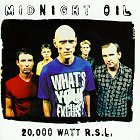 Very seldom, at least in my mind, does highly-politicized music have real honest-to-God talent to back up the message. Peter Garrett and Midnight Oil have always earned my admiration by making the sound of their message appealing. Garrett and company are famous for putting the plight of the Australian aborigine, the working-class laborer, and the environment to the sound of music. And damned good music, at that – there’s not a song on this compilation that makes me want to skip it. Whether the songs are older or brand new, the unique sound of Midnight Oil is one of the most distinctive sounds I remember from the late 80s and early 90s. Most people will recall the more popular songs such as “Blue Sky Mine” and “Beds Are
Very seldom, at least in my mind, does highly-politicized music have real honest-to-God talent to back up the message. Peter Garrett and Midnight Oil have always earned my admiration by making the sound of their message appealing. Garrett and company are famous for putting the plight of the Australian aborigine, the working-class laborer, and the environment to the sound of music. And damned good music, at that – there’s not a song on this compilation that makes me want to skip it. Whether the songs are older or brand new, the unique sound of Midnight Oil is one of the most distinctive sounds I remember from the late 80s and early 90s. Most people will recall the more popular songs such as “Blue Sky Mine” and “Beds Are  Burning”, but my favorite remains the not-quite-#1 single “The Dead Heart”, with its infectious chiming guitars, French horns and backing vocals that beg you to sing along, lending it a particularly unique flavor. Some of the lesser-known gems deserve to be heard too, including “U.S. Forces”, the slightly U2-ish “One Country”, and “Forgotten Years”.
Burning”, but my favorite remains the not-quite-#1 single “The Dead Heart”, with its infectious chiming guitars, French horns and backing vocals that beg you to sing along, lending it a particularly unique flavor. Some of the lesser-known gems deserve to be heard too, including “U.S. Forces”, the slightly U2-ish “One Country”, and “Forgotten Years”.
- What Goes On (2:56)
- Power And The Passion (5:41)
- Dreamworld (3:36)
- White Skin, Black Heart (3:45)
- Koscluszko (4:41)
- The Dead Heart (5:12)
- Blue Sky Mine (4:20)
- U.S. Forces (4:08)
- Beds Are Burning (4:19)
- One Country (5:54)
- Best Of Both Worlds (4:05)
- Truganini (5:12)
- King Of The Mountain (3:49)
- Hercules (4:31)
- Surf’s Up Tonight (3:06)
- Back On The Borderline (3:11)
- Don’t Wanna Be The One (3:02)
- Forgotten Years (4:22)
Released by: Columbia
Release date: 1997
Total running time: 75:54
Star Trek: The Motion Picture – 20th Anniversary Edition
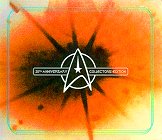 Thank God! After years of waiting – literally years – the remastered Star Trek: The Motion Picture soundtrack is available. Up until the 11th hour in December 1998, this 2-CD set was intended to be released at the same time as Star Trek: Insurrection‘s soundtrack and Ron Jones’ original music from the CD-ROM game Star Trek: Starfleet Academy. But Paramount’s marketing wing blanched at the thought of three simultaneous Star Trek music releases, and demanded that this collection and the Starfleet Academy album be held back indefinitely. Alas, Sonic Images’ Starfleet Academy CD has yet to see the light of day, but after hearing this digitally remastered soundtrack with its wealth of previously unreleased material, I begin to see why the Paramount brass was so worried. The power, exotic beauty and timelessness of the first Trek film’s soundtrack – even though composed by the same man who scored Star Trek: Insurrection – easily outshines damn near any other Star Trek CD that could’ve been released at the same time.
Thank God! After years of waiting – literally years – the remastered Star Trek: The Motion Picture soundtrack is available. Up until the 11th hour in December 1998, this 2-CD set was intended to be released at the same time as Star Trek: Insurrection‘s soundtrack and Ron Jones’ original music from the CD-ROM game Star Trek: Starfleet Academy. But Paramount’s marketing wing blanched at the thought of three simultaneous Star Trek music releases, and demanded that this collection and the Starfleet Academy album be held back indefinitely. Alas, Sonic Images’ Starfleet Academy CD has yet to see the light of day, but after hearing this digitally remastered soundtrack with its wealth of previously unreleased material, I begin to see why the Paramount brass was so worried. The power, exotic beauty and timelessness of the first Trek film’s soundtrack – even though composed by the same man who scored Star Trek: Insurrection – easily outshines damn near any other Star Trek CD that could’ve been released at the same time.
Disc one not only adds nearly half an hour of previously unreleased music from that first movie, but every cue is crisply remastered and sequenced in order of its original appearance in the movie. This places the lovely theme for the short-lived Lt. Ilia first on the disc, since it appeared in the movie as an overture over a blank screen. The second disc includes the entire contents of the hitherto hard-to-find Inside Star Trek LP released by Columbia in 1976. Inside Star Trek features several late luminaries – Gene Roddenberry, Mark Lenard, Isaac Asimov – discussing and lecturing on science fiction in general, and of course, Star Trek in particular. William Shatner and DeForest Kelley also appear on the album, which now has newly-recorded introductory and closing material by Nichelle Nichols. Inside Star Trek is seriously fannish novelty material. I have the original LP, given to me by a friend several years ago, and having heard it long ago, never expected to see an official CD release.
But back to the music from Star Trek: The Motion Picture. One quickly realizes that most of the material which is being heard on CD for the first time here makes up some of the score’s quieter moments – “Total Logic”, the cue which accompanies Spock’s rejection of Kolinahr; “Games”, a nicely understated cue which played under a scene of Decker trying to reacquaint an alien probe in the form of Lt. Ilia with her original memories, and a few others. Many of them are less otherworldly-sounding than the blaster beam laden V’Ger cues, but all of them are epic in scale and amazing to hear at full blast.
 Though the “bonus CD” renders this a slightly more expensive purchase than usual, I cannot recommend the 20th anniversary edition of the Star Trek: The Motion Picture soundtrack highly enough. Though the long wait for this release has been frustrating, to say the least, it’s definitely worth the wait.
Though the “bonus CD” renders this a slightly more expensive purchase than usual, I cannot recommend the 20th anniversary edition of the Star Trek: The Motion Picture soundtrack highly enough. Though the long wait for this release has been frustrating, to say the least, it’s definitely worth the wait.
Disc one
- Ilia’s Theme (3:01)
- Main Title (1:23)
- Klingon Attack (5:27)
- Total Logic (3:34)
- Floating Office (1:03)
- The Enterprise (5:59)
- Leaving Drydock (3:29)
- Spock’s Arrival (1:58)
- The Cloud (4:58)
- V’Ger Flyover (4:57)
- The Force Field (5:03)
- Games (3:41)
- Spock Walk (4:19)
- Inner Workings (3:09)
- V’Ger Speaks (3:50)
- The Meld (3:09)
- A Good Start (2:26)
- End Title (3:16)
Disc two
- Star Trek Theme (1:34)
- Introduction – Nichelle Nichols (1:13)
- Inside Star Trek (1:04)
- William Shatner Meets Captain Kirk (9:12)
- Introduction to live show (0:25)
- About Science Fiction (0:40)
- The Origin of Spock (1:45)
- Sarek’s Son Spock – Mark Lenard (7:21)
- The Questor Affair (3:49)
- The Genesis II Pilot (2:34)
- Cyborg Tools and E.T. Life Forms (4:06)
- McCoy’s Rx for Life – DeForest Kelley (6:14)
- The Star Trek Philosophy – Gene Roddenberry (4:40)
- Asimov’s World of Science Fiction – Isaac Asimov (6:27)
- The Enterprise Runs Aground (1:50)
- A Letter from a Network Censor – Gene Roddenberry (5:03)
- The Star Trek Dream (Ballad I/Ballad II) (5:43)
- Sign-Off – Nichelle Nichols (0:50)
Released by: Columbia / Sony Legacy
Release date: 1999
Disc one total running time: 67:12
Disc two total running time:
Babylon 5: Whatever Happened To Mr. Garibaldi?
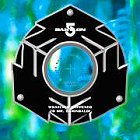 This is another Babylon 5 episodic soundtrack I didn’t originally plan to buy, figuring that most of the music had been used elsewhere. Once again, I was proven wrong in this regard – the score to Whatever Happened, though numerous elements are lifted from or recycled by other episodes, is interesting and has several unique moments. A distinct and eerie theme runs through the scenes in which Sheridan is trapped with the ancient being known only as Lorien, and more specifically, in those scenes where Lorien delivers and reiterates his “tick, you’re alive, tock, you’re dead” speech, a chiming, clock-life motif can be heard…and that has to rate as one of the most clever, possibly the most clever musical metaphor that Christopher Franke has ever utilized in a Babylon 5 soundtrack. The “Delenn Addresses The Rangers” cue is another highlight, opening with a sweeping, heroic theme that I
This is another Babylon 5 episodic soundtrack I didn’t originally plan to buy, figuring that most of the music had been used elsewhere. Once again, I was proven wrong in this regard – the score to Whatever Happened, though numerous elements are lifted from or recycled by other episodes, is interesting and has several unique moments. A distinct and eerie theme runs through the scenes in which Sheridan is trapped with the ancient being known only as Lorien, and more specifically, in those scenes where Lorien delivers and reiterates his “tick, you’re alive, tock, you’re dead” speech, a chiming, clock-life motif can be heard…and that has to rate as one of the most clever, possibly the most clever musical metaphor that Christopher Franke has ever utilized in a Babylon 5 soundtrack. The “Delenn Addresses The Rangers” cue is another highlight, opening with a sweeping, heroic theme that I  don’t remember ever hearing in another episode, almost main title theme material. And another source music surprise is heard in the form of the music playing in the bar where G’Kar is trying to trackdown Garibaldi’s whereabouts (to be honest, I’d never really noticed music in that scene before). In summary, it’s a far more distinctive and worthwhile release than I originally gave it credit for!
don’t remember ever hearing in another episode, almost main title theme material. And another source music surprise is heard in the form of the music playing in the bar where G’Kar is trying to trackdown Garibaldi’s whereabouts (to be honest, I’d never really noticed music in that scene before). In summary, it’s a far more distinctive and worthwhile release than I originally gave it credit for!
- Franklin’s Log / Sheridan, The Living Dead / Main Title (4:27)
- Between Moments / Tic-Toc / Bar Source / G’Kar Picks A Fight / Delenn’s
Grief (9:00)- Hiding Place / Friendship / Marcus Investigates / G’Kar Ambushed (4:47)
- Delenn Addresses Rangers / G’Kar, The Present (5:16)
- G’Kar and Londo Bargain / The First One (2:33)
- Lorien’s Explanation / Lorien’s Advice / End Title (5:04)
Released by: Sonic Images
Release date: 1998
Total running time: 28:41
Babylon 5: War Without End, Part Two
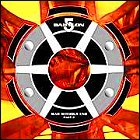 As I’ve mentioned already, I was glad to see Sonic Images release the soundtrack of both halves of War Without End, primarily because most of this two-parter’s music was never included on the second of the Babylon 5 compilation CDs, despite including some of the show’s most memorable moments. The “Delenn In Love” and “Delenn Leaves” cues feature a quiet, beautiful, and wistful theme for the aged Delenn of the future lamenting the fate that was soon to befall Sheridan. “Babylon 4 Disappears” and “Time Travel Arrival” are some of the best suspense music to appear in the series, and “Old Crew Approach” features the welcome return of the original Babylon 5 series theme in a time-bending moment where Sinclair and Garibaldi – as we saw them in the first season of the show – arrive in the “present” timeline (if indeed such a term can even be used in association with War Without End without confusing things further!). And there’s an amazing passage of flowing woodwinds and harps in the Babylon 4 Transfer cue – an incredible departure from Babylon 5’s usual reliance on electronics! Both parts of War Without End featured some grand music, and it’s nice to see that they’ve finally earned their place among the other episodes whose scores have been
As I’ve mentioned already, I was glad to see Sonic Images release the soundtrack of both halves of War Without End, primarily because most of this two-parter’s music was never included on the second of the Babylon 5 compilation CDs, despite including some of the show’s most memorable moments. The “Delenn In Love” and “Delenn Leaves” cues feature a quiet, beautiful, and wistful theme for the aged Delenn of the future lamenting the fate that was soon to befall Sheridan. “Babylon 4 Disappears” and “Time Travel Arrival” are some of the best suspense music to appear in the series, and “Old Crew Approach” features the welcome return of the original Babylon 5 series theme in a time-bending moment where Sinclair and Garibaldi – as we saw them in the first season of the show – arrive in the “present” timeline (if indeed such a term can even be used in association with War Without End without confusing things further!). And there’s an amazing passage of flowing woodwinds and harps in the Babylon 4 Transfer cue – an incredible departure from Babylon 5’s usual reliance on electronics! Both parts of War Without End featured some grand music, and it’s nice to see that they’ve finally earned their place among the other episodes whose scores have been  demanded by B5 fans.
demanded by B5 fans.
My only complaint after listening to these two? Since War Without End was a heavily interconnected two-part show, perhaps it should have merited a full length release, a la In The Beginning.
- Looking Back / Sheridan’s Arrest / Freeze / Main Title (4:24)
- Sheridan Lost in Time / Delenn in Love / Delenn Leaves (4:12)
- Londo’s Reception / Londo’s Fate Revealed / Unfinished Business / Sheridan’s
First Return / Babylon 4 Disappears (5:31)- Time Travel Arrival / Time Flash / Old Crew Approach / Zathras Arrested
(2:54)- Babylon 4 Transfer / Zathras Revelation / Let’s Go Home (10:24)
- Sinclair’s Transformation / Valen Appears / End Title (3:41)
Released by: Sonic Images
Release date: 1998
Total running time: 32:41
Babylon 5: War Without End, Part One
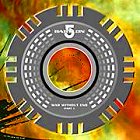 Perhaps not surprisingly, fan and customers didn’t request the music from this popular third season two-parter – they demanded it. The music from both parts is quite unique, and served as the first appearance of many themes, from the foreboding sound later associated with Sheridan’s suicidal leap at Z’ha’dum, to the flowing orchestral tension motif which would later be heard in Falling Toward Apotheosis, among others. But there are several unique moments here which never appeared again, like the recurring heroic-but-weary motif heard in several White Star scenes, or the slightly humorous yet still enigmatic chiming sound which often seemed to be associated with Sinclair. There
Perhaps not surprisingly, fan and customers didn’t request the music from this popular third season two-parter – they demanded it. The music from both parts is quite unique, and served as the first appearance of many themes, from the foreboding sound later associated with Sheridan’s suicidal leap at Z’ha’dum, to the flowing orchestral tension motif which would later be heard in Falling Toward Apotheosis, among others. But there are several unique moments here which never appeared again, like the recurring heroic-but-weary motif heard in several White Star scenes, or the slightly humorous yet still enigmatic chiming sound which often seemed to be associated with Sinclair. There  are also some wonderful choral effects heard in the brief opening scenes set on Minbar, and a strange percussive passage for the Great Machine of Epsilon 3 (and its keepers, Zathras and other creatures like him). Along with the second part of this two-part epic, this is worth the time to sit and listen to closely.
are also some wonderful choral effects heard in the brief opening scenes set on Minbar, and a strange percussive passage for the Great Machine of Epsilon 3 (and its keepers, Zathras and other creatures like him). Along with the second part of this two-part epic, this is worth the time to sit and listen to closely.
- Minbari Homeworld / Opening the Mystery Box / Main Title (4:00)
- Sinclair Ship Ready / Return to the Beginning / ID Check / Epsilon 3 (6:04)
- Delenn’s Request / Vision of Destruction / Delenn’s Explanation (5:26)
- Sheridan’s Reaction / Delenn / Sinclair’s Flashback / Garibaldi Sent Home /
Go To The Rift (4:53)- Time Travel / Shadow Bomb / Interception / Sheridan Captured (6:19)
- Delenn Worried / No Doubts / Londo’s Revenge / Tradition / End Title (3:24)
Released by: Sonic Images
Release date: 1998
Total running time: 32:04
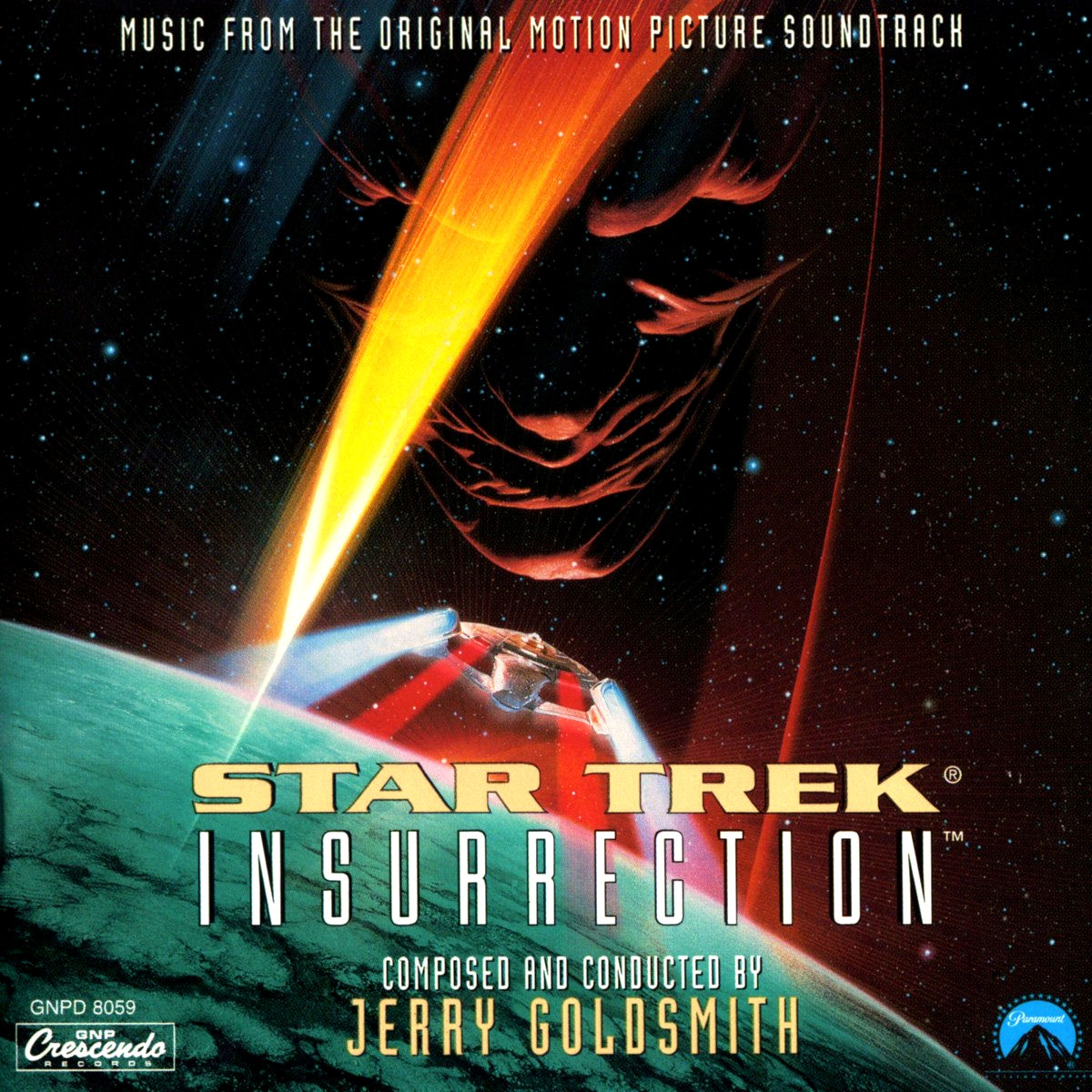
Star Trek: Insurrection – music by Jerry Goldsmith
 Jerry Goldsmith returns once again to the Trekkian realm for the most recent feature film exploits of the Enterprise crew, and the results are…well…familiar.
Jerry Goldsmith returns once again to the Trekkian realm for the most recent feature film exploits of the Enterprise crew, and the results are…well…familiar.
Now, I’m not putting Mr. Goldsmith in the same category as a certain Mr. Horner, who only seems to come up with an original melody once every dozen years or so. Far from it. Whatever Jerry Goldsmith does, its stamp belongs solely to that one movie. But the style is what seals it for me in the case of Star Trek: Insurrection. So much of this album sounds so much like Star Trek: First Contact that it’s hard not to make the comparison.
Surprisingly, for a film that dealt with the Borg and virtually reinvented their entire mythos (just in time for a Borg revival on Star Trek: Voyager), First Contact‘s primary theme was surprisingly, if pleasantly, pastoral and calm. And Insurrection opens on the same note. Actually, every Trek film that Goldsmith has scored since 1989 has opened with the same notes: the segue from the Alexander Courage theme into the Star Trek: The Motion Picture theme that was first heard in Star Trek V: The Final Frontier. Thereafter, the music takes on a gentle, flowing feel, and at least this time there are peaceful scenes of an idyllic Ba’ku village (also the title of the first track on the CD) to back up the music, rather than out-of-focus credits. (To be fair, that’s more a comparison of the films’ visuals, not the music.)
Before long, a sinister tone creeps into the proceedings as Data appears to go on the rampage. An electronic arpeggio motif makes its first appearance at this point in the music, and that same motif runs through virtually every action cue on the disc. Not that the action cues aren’t good, but this electronic arpeggio makes all of those pieces sound more similar than they actually are in musical terms. Some of the best music occurs in “The Healing Process”, an early version of the film’s final action cue (the packaging notes that this isn’t the final version of the cue) whose fierce action culminates in a grandiose burst of electronics, acoustic instruments, and a brief hint of synthesized choir. That moment comes closer to the sweeping majesty of Goldsmith’s Star Trek: The Motion Picture score than any other frame of Trek that he has scored since 1979. It’s a neat bit of music, to say the least!
Overall, one gets the distinct impression that Jerry Goldsmith’s heart just isn’t into making music for Star Trek movies anymore, and having composed the music for nearly half of those films thus far, he’s entitled to feel  that way. Though the man is still obviously a musical genius, the repetition inherent in the Star Trek: Insurrection soundtrack could be a sign that, sometime early in the next century when the tenth Star Trek movie goes before the cameras, with or without all of its stars, it may be time to hand the composing duties to someone new.
that way. Though the man is still obviously a musical genius, the repetition inherent in the Star Trek: Insurrection soundtrack could be a sign that, sometime early in the next century when the tenth Star Trek movie goes before the cameras, with or without all of its stars, it may be time to hand the composing duties to someone new.
- Ba’ku Village (6:52)
- In Custody (1:14)
- Children’s Story (1:47)
- Not Functioning (1:45)
- New Sight (5:44)
- The Drones Attack (4:18)
- The Riker Maneuver (3:09)
- The Same Race (1:16)
- No Threat (4:12)
- The Healing Process (7:15)
- End Credits (5:25)
Released by: GNP Crescendo
Release date: 1998
Total running time: 41:29
Grayghost – The End of the Old
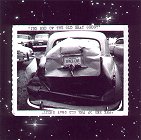 Grayghost is a band with which I’m intimately acquainted, thanks to sheer repetition and osmosis. Why is this? Grayghost was one of the frequently recurring house bands at Old Town Grain & Feed, a bar in downtown Fort Smith which also had some apartments upstairs. I lived there for three years, and got to hear plenty of Grayghost nearly every Friday night. I’ll admit, Grayghost rocks hard and plays loud, so this did make sleep somewhat difficult at times. But with the benefit of living a thousand miles now, I find that I actually miss a lot of their original numbers. Grayghost could belt out some mean covers, but their original songs are truly unique. Though this CD varies wildly from their usual live set list, it’s still a decent document of their most-requested songs. Included are the wild guitar solo “Hale-Bopp” (which makes a stellar segue into “Mars”), “Train”, “X-Ray”, the reggae-rocker “Drive”, and hard rockers “Naked” and “Suicide”. Grayghost’s female lead vocalist sometimes sounds like she’s swallowed a cup full of razor blades, but at other times she
Grayghost is a band with which I’m intimately acquainted, thanks to sheer repetition and osmosis. Why is this? Grayghost was one of the frequently recurring house bands at Old Town Grain & Feed, a bar in downtown Fort Smith which also had some apartments upstairs. I lived there for three years, and got to hear plenty of Grayghost nearly every Friday night. I’ll admit, Grayghost rocks hard and plays loud, so this did make sleep somewhat difficult at times. But with the benefit of living a thousand miles now, I find that I actually miss a lot of their original numbers. Grayghost could belt out some mean covers, but their original songs are truly unique. Though this CD varies wildly from their usual live set list, it’s still a decent document of their most-requested songs. Included are the wild guitar solo “Hale-Bopp” (which makes a stellar segue into “Mars”), “Train”, “X-Ray”, the reggae-rocker “Drive”, and hard rockers “Naked” and “Suicide”. Grayghost’s female lead vocalist sometimes sounds like she’s swallowed a cup full of razor blades, but at other times she  sounds like a throatier, sexier Janis Joplin; “Train” and “Already” are good examples of this. On a couple of songs, namely “Naked”, the vocals are almost too processed to make any kind of sense of them, but it’s not necessary – it’s not as if any of the singing is so bad that it needs to be phased, flanged, and echoed to cover it up.
sounds like a throatier, sexier Janis Joplin; “Train” and “Already” are good examples of this. On a couple of songs, namely “Naked”, the vocals are almost too processed to make any kind of sense of them, but it’s not necessary – it’s not as if any of the singing is so bad that it needs to be phased, flanged, and echoed to cover it up.
- Miracle (3:26)
- Spaceman (2:56)
- Mexico (2:43)
- Skin (4:54)
- X-Ray (3:35)
- Bikini (3:39)
- Drive (4:23)
- Hale-Bopp (1:52)
- Mars (3:53)
- Stupid (3:34)
- Catholic (3:08)
- Fiddle (0:57)
- Train (2:50)
- Naked (3:29)
- Suicide (4:16)
- Already (4:01)
Released by: Fat Rabbit
Release date: 1997
Total running time: 53:31
Babylon 5: Lines Of Communication
 This episode, featuring the first full appearance of the Drakh (the primary enemy in Crusade) in Babylon 5 lore, should’ve had a much more distinctive musical score than it gets here. There are some unique touches, such as a horror-film-inspired musical “stabbing” motif for the Drakh, and a strange synthesized sound which seems inspired by the glass rod, which is often used as a musical signature for the otherworldly and the terrifying. I’d also swear that there are hints of electric guitar, or perhaps a sample thereof, cutting into the proceedings as Delenn launches a devastating counterattack on the Drakh fleet. But other than that…there isn’t anything new in a strictly musical sense aside from some unusual
This episode, featuring the first full appearance of the Drakh (the primary enemy in Crusade) in Babylon 5 lore, should’ve had a much more distinctive musical score than it gets here. There are some unique touches, such as a horror-film-inspired musical “stabbing” motif for the Drakh, and a strange synthesized sound which seems inspired by the glass rod, which is often used as a musical signature for the otherworldly and the terrifying. I’d also swear that there are hints of electric guitar, or perhaps a sample thereof, cutting into the proceedings as Delenn launches a devastating counterattack on the Drakh fleet. But other than that…there isn’t anything new in a strictly musical sense aside from some unusual  instrumentation. One piece of music established here, a frenetic, brutal string passage, would resurface in future battle scenes such as those in Endgame and The Ragged Edge, but there’s very little new here for those who have already heard those releases. Unless you’re a completist, this is a Babylon 5 episodic CD you can safely skip.
instrumentation. One piece of music established here, a frenetic, brutal string passage, would resurface in future battle scenes such as those in Endgame and The Ragged Edge, but there’s very little new here for those who have already heard those releases. Unless you’re a completist, this is a Babylon 5 episodic CD you can safely skip.
- ISN Propaganda / Message from Mars / Bad Situation / Main Title (4:21)
- Lines of Communication / An Independent Woman / How To Treat an Ex-Lover /
Wake-Up Call / Ivanova Volunteers (3:57)- Concerns About Minbari / The Mars Conspiracy / Independence Promise /
Minbari Hold-Up (4:45)- Forell Takes Over / Calls of Passion (8:54)
- Skin Dancing / Drakhs Pay The Price (6:00)
- War Room Turned Studio / All Hands Full / End Title (4:19)
Released by: Sonic Images
Release date: 1998
Total running time: 31:44
Babylon 5: Endgame
 This pivotal episode – wrapping up the show’s plot threads early at the end of season four in case the series wasn’t renewed for a fifth year – demanded some outstanding music, and got it in spades, though the soundtrack for Endgame isn’t without flaws. Once again, I have to criticize Christopher Franke for reusing material. I cited this gripe with In The Beginning, and here it happens again. The somber theme, first introduced as “Londo And G’Kar In Trouble” on the No Surrender, No Retreat soundtrack, returns no less than three times in the space of this 36-minute CD – it’s the official musical accompaniment of every quietly serious moment in Babylon 5’s fourth season. Building upon themes is one thing – themes that accompany specific situations and characters have made many movie and TV scores immortal to their listeners. But this particular piece of music was haphazardly jammed in wherever it would fit during the latter half of that season (and a large chunk of “Taking Back Earth”, the part which accompanied Sheridan’s ultimatum, was jammed into Delenn’s speech to Earth’s heads of state in the following episode, even though it was barely appropriate to the situation. As I’ve mentioned elsewhere, the famous “jump now!” cue didn’t originate with Z’Ha’Dum – it was first heard in part one of War Without End. That cue was used in consistent situations whenever it resurfaced. This cue…isn’t. And I’m not going to mention “Mars Attack”‘s inclusion of a cue from a Franke movie score that predates Babylon 5 altogether!
This pivotal episode – wrapping up the show’s plot threads early at the end of season four in case the series wasn’t renewed for a fifth year – demanded some outstanding music, and got it in spades, though the soundtrack for Endgame isn’t without flaws. Once again, I have to criticize Christopher Franke for reusing material. I cited this gripe with In The Beginning, and here it happens again. The somber theme, first introduced as “Londo And G’Kar In Trouble” on the No Surrender, No Retreat soundtrack, returns no less than three times in the space of this 36-minute CD – it’s the official musical accompaniment of every quietly serious moment in Babylon 5’s fourth season. Building upon themes is one thing – themes that accompany specific situations and characters have made many movie and TV scores immortal to their listeners. But this particular piece of music was haphazardly jammed in wherever it would fit during the latter half of that season (and a large chunk of “Taking Back Earth”, the part which accompanied Sheridan’s ultimatum, was jammed into Delenn’s speech to Earth’s heads of state in the following episode, even though it was barely appropriate to the situation. As I’ve mentioned elsewhere, the famous “jump now!” cue didn’t originate with Z’Ha’Dum – it was first heard in part one of War Without End. That cue was used in consistent situations whenever it resurfaced. This cue…isn’t. And I’m not going to mention “Mars Attack”‘s inclusion of a cue from a Franke movie score that predates Babylon 5 altogether!
However, “Taking Back Earth”, heard on Endgame in its first appearance, may well be the best reason to get this CD. That epic 11-minute cue – comprising almost an entire third of the album! – covers Sheridan’s forces’ battle to free Earth from the tyrannical reign of President Clark, and is an extremely intense  listening experience, even without the visuals with which it is associated. The 6-minute long “Mars Attack” cue is also excellent, and it was reused heavily on In The Beginning. And last but not least, there’s also the “ISN News Jingle”, a nice little bonus bit of “source” music – meaning that, unlike the underscore, the characters in the show can hear it – that I really didn’t expect to hear on CD anytime soon.
listening experience, even without the visuals with which it is associated. The 6-minute long “Mars Attack” cue is also excellent, and it was reused heavily on In The Beginning. And last but not least, there’s also the “ISN News Jingle”, a nice little bonus bit of “source” music – meaning that, unlike the underscore, the characters in the show can hear it – that I really didn’t expect to hear on CD anytime soon.
- Marcus on Death Watch / The Final Strike / Scouting Mars Targets / Main
Title (6:03)- Taking Mars Bunker / Captain’s Final Briefing / Sheridan’s Old Teacher
(3:02)- Battle On Mars (6:20)
- Awakening Telepath / Babylon 5 Files (3:49)
- Taking Back Earth (10:59)
- ISN Jingle / Alien Healing Device / End Title (3:39)
Released by: Sonic Images
Release date: 1998
Total running time: 35:25
Art of Noise – The FON Mixes
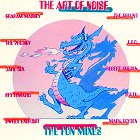 Hardly a substitute for any new noise from the Art of Noise, this album is a collection of DJ mixes of various Art of Noise tunes, often mixing and matching elements from numerous pieces. It would be much more interesting if even half of the album was actually Art of Noise originated – most of it, in fact, is not. I suppose that this could be an element of house mixing that I’m not aware of – entirely possible since I got this album more for the Art of Noise element than the house music aspect, but entire tracks pass where you may hear no more than ten notes or beats that are familiar! Too much of a curiosity for all but the most diehard Noise fans, I suspect, but certainly a treat for the dance crowd. Still, the house style – no pun
Hardly a substitute for any new noise from the Art of Noise, this album is a collection of DJ mixes of various Art of Noise tunes, often mixing and matching elements from numerous pieces. It would be much more interesting if even half of the album was actually Art of Noise originated – most of it, in fact, is not. I suppose that this could be an element of house mixing that I’m not aware of – entirely possible since I got this album more for the Art of Noise element than the house music aspect, but entire tracks pass where you may hear no more than ten notes or beats that are familiar! Too much of a curiosity for all but the most diehard Noise fans, I suspect, but certainly a treat for the dance crowd. Still, the house style – no pun  intended – as well as industrial owe a lot to the Art of Noise, so it’s only fitting that they repay that debt. Once you get past the relative absence of the Art of Noise, it’s actually quite enjoyable! My favorite bit has to be “I Of The Needled”, which contains few if any elements that I recognize as coming from any Art of Noise song, but is still fun to listen to.
intended – as well as industrial owe a lot to the Art of Noise, so it’s only fitting that they repay that debt. Once you get past the relative absence of the Art of Noise, it’s actually quite enjoyable! My favorite bit has to be “I Of The Needled”, which contains few if any elements that I recognize as coming from any Art of Noise song, but is still fun to listen to.

- Instruments of Darkness (All Of Us Are One People), the Prodigy mix (3:38)
- Yebo (Interlude 1), a Mark Gamble mix (1:18)
- Roller 10 – the Rhythmatic Mix (4:47)
- Back to Backbeat – the Robert Gordon Mix (4:28)
- Shades of Paranoimia – the Carl Cox Mix (3:43)
- Ode to a D.J. (Interlude 2), a Mark Gamble Mix (1:10)
- Catwalk – the Ground Mix (5:02)
- Dragnet and Peter Gunn Have a Day at the Races, remixed by Mark Gamble (1:27)
- Legs – the Graham Massey Mix (3:18)
- L.E.F. – the Mark Brydon Mix (5:00)
- I of the Needled – the Sweet Exorcist Mix (4:35)
- Crusoe – the LFO Mix (3:44)
- The Art of Slow Love, remixed by Youth (5:13)
- No Sun (Interlude 4), a Mark Gamble mix (1:48)
Released by: China Records
Release date: 1991
Total running time: 49:11
Babylon 5: Chrysalis
 Babylon 5 is one of those shows where missing one key episode can leave you clueless when watching future episodes, and Chrysalis – which first aired in October 1994 – was just such a pivotal episode. The final episode of the show’s first season, Chrysalis set plot threads into motion that would affect the series permanently. The music was easily the first season’s most memorable, and firmly set the scoring style for the show on a more percussive path rather than a predominantly new-age-esque tone (which can also be heard clearly on Chrysalis). Chrysalis includes such immortal moments as the injured Garibaldi trying to reach Sinclair to warn him about the attempt on the Earth president’s life, Delenn offering to share the secret of the Battle of the Line, and the first time we see Kosh revealing his true nature to any of the other characters. The early scoring style of Babylon 5 leaned heavily toward new age influences, but in this case – especially those scenes involving the crysalline device that transforms Delenn – it works to the advantage of this episode. There are also two bits of source music here, including the song “Believe Me Now” (a very short, early-80’s-new-wave-style pop song heard in the background of the nightclub where Garibaldi finds Devereaux), and “Cheers”, the little chunk of thumpin’ house music played as the clock strikes midnight on 2258 (actually an excerpt from Franke’s solo album Klemania).
Babylon 5 is one of those shows where missing one key episode can leave you clueless when watching future episodes, and Chrysalis – which first aired in October 1994 – was just such a pivotal episode. The final episode of the show’s first season, Chrysalis set plot threads into motion that would affect the series permanently. The music was easily the first season’s most memorable, and firmly set the scoring style for the show on a more percussive path rather than a predominantly new-age-esque tone (which can also be heard clearly on Chrysalis). Chrysalis includes such immortal moments as the injured Garibaldi trying to reach Sinclair to warn him about the attempt on the Earth president’s life, Delenn offering to share the secret of the Battle of the Line, and the first time we see Kosh revealing his true nature to any of the other characters. The early scoring style of Babylon 5 leaned heavily toward new age influences, but in this case – especially those scenes involving the crysalline device that transforms Delenn – it works to the advantage of this episode. There are also two bits of source music here, including the song “Believe Me Now” (a very short, early-80’s-new-wave-style pop song heard in the background of the nightclub where Garibaldi finds Devereaux), and “Cheers”, the little chunk of thumpin’ house music played as the clock strikes midnight on 2258 (actually an excerpt from Franke’s solo album Klemania).
Fan favorites such as the music accompanying the assassination of the Earth Alliance president, and Garibaldi’s dying struggle to warn Sinclair about the impending plot, are heard here unedited for the first time (both pieces were included in altered form on the first Babylon 5 compilation CD, released in 1995). My personal favorite here, however, has to be the soft but menacing piece heard as Delenn prepares to reveal her true purpose to Sinclair (which leads into one of the aforementioned Garibaldi cues). Even as I first heard that on TV, that cue sent chills up my spine, and it repeats a musical motif heard elsewhere in higher registers throughout the episode’s score, symbolizing the imminence of Delenn’s change.
 Chrysalis has turned out to be one of my favorites of the Babylon 5 episodic CD range, and I hope that, even if the first-season musical scores came up a bit shorter than even 30 minutes, Sonic Images will continue to release them, perhaps opting to pair up shorter scores on a single CD.
Chrysalis has turned out to be one of my favorites of the Babylon 5 episodic CD range, and I hope that, even if the first-season musical scores came up a bit shorter than even 30 minutes, Sonic Images will continue to release them, perhaps opting to pair up shorter scores on a single CD.
- Into the Conference / Death of the Informant / Main Title (3:27)
- Medlab / July is Better / See You In An Hour / I Knew Him / Things To Come /
I Must See (4:06)- Believe Me / Send the Message / I Don’t Like Where We Are Going / I Don’t
Like This / The Attack (5:50)- He Wouldn’t / I Do Not Have Much Time / There Is Someone Else / Cheers /
Time (6:09)- Too Late / The Point of the Exercise / She is Changing (3:30)
- Transmission / Destiny / End Title (2:30)
Released by: Sonic Images
Release date: 1998
Total running time: 24:51
Red Hot Chili Peppers – One Hot Minute
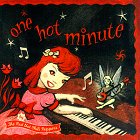 This is one of those rare albums of which I like approximately half, and can’t stand the other half. Like a lot of people who don’t delve too deep into the hard rock scene, my first exposure to the Chilis was the atypical ballad “Under The Bridge” in 1991, but I warmed to some of their other songs, even the oddball pseudo-rap “Take It Away”. Which brings us to this album. Why did I get it? Because I love “Aeroplane” – what a wild song! But that’s not the only good song on this album. Also check
This is one of those rare albums of which I like approximately half, and can’t stand the other half. Like a lot of people who don’t delve too deep into the hard rock scene, my first exposure to the Chilis was the atypical ballad “Under The Bridge” in 1991, but I warmed to some of their other songs, even the oddball pseudo-rap “Take It Away”. Which brings us to this album. Why did I get it? Because I love “Aeroplane” – what a wild song! But that’s not the only good song on this album. Also check  out “Walkabout” and my new favorite Chilis tune, “My Friends”. It seems like every other track on this album appeals to me, but the alternating ones are surefire skip material. Which sums up my approach to the Red Hot Chili Peppers in general.
out “Walkabout” and my new favorite Chilis tune, “My Friends”. It seems like every other track on this album appeals to me, but the alternating ones are surefire skip material. Which sums up my approach to the Red Hot Chili Peppers in general.
- Warped (5:04)
- Aeroplane (4:45)
- Deep Kick (6:34)
- My Friend (4:03)
- Coffee Shop (3:09)
- Pea (1:47)
- One Big Mob (6:03)
- Walkabout (5:07)
- Tearjerker (4:19)
- One Hot Minute (6:24)
- Falling Into Grace (3:48)
- Shallow Be Thy Game (4:34)
- Transcending (5:47)
Released by: Warner Bros.
Release date: 1995
Total running time: 69:24
Babylon 5: The Coming Of Shadows
 Babylon 5’s first Hugo-winning episode was a winner from the word go, and the people making it knew this. The actors knew they were working with first-rate material, and rose to the occasion. And it’s also likely that Christopher Franke was given directions to make the music for the episode unique, which was not a problem early in the second season, when Franke was consistently generating some of his most innovative material for Babylon 5. The music from The Coming Of Shadows is percussive, aggressive, and helps propel the episode along its juggernaut path of destiny. In many cases, with dialogue and sound effects stripped away, The Coming Of Shadows is one of the most percussive scores in the history of the show, especially in the second season, which was heavier on mood and sinister atmosphere than on pounding war drums. Even seemingly simple scenes as Garibaldi putting a mysterious visitor under arrest for lurking around suspiciously is given a percussive flourish. But
Babylon 5’s first Hugo-winning episode was a winner from the word go, and the people making it knew this. The actors knew they were working with first-rate material, and rose to the occasion. And it’s also likely that Christopher Franke was given directions to make the music for the episode unique, which was not a problem early in the second season, when Franke was consistently generating some of his most innovative material for Babylon 5. The music from The Coming Of Shadows is percussive, aggressive, and helps propel the episode along its juggernaut path of destiny. In many cases, with dialogue and sound effects stripped away, The Coming Of Shadows is one of the most percussive scores in the history of the show, especially in the second season, which was heavier on mood and sinister atmosphere than on pounding war drums. Even seemingly simple scenes as Garibaldi putting a mysterious visitor under arrest for lurking around suspiciously is given a percussive flourish. But  there are also less bombastic cues, such as the wistful passage accompanying the scenes of the Centauri Emperor’s lament that he has never made his own decisions – as well as the dark mood of the cue in which Londo realizes he has thwarted the now-dead Emperor’s dying wish for peace.
there are also less bombastic cues, such as the wistful passage accompanying the scenes of the Centauri Emperor’s lament that he has never made his own decisions – as well as the dark mood of the cue in which Londo realizes he has thwarted the now-dead Emperor’s dying wish for peace.
- Imperial Palace / Emperor’s Exit / Request Denied / Main Title (3:07)
- Doing Business / Preparing the Speech / G’Kar Gets Ready (2:52)
- Greeting the Emperor / Reflection On Life / G’Kar’s Will / Emperor
Collapses / Londo’s Plan (5:33)- Bad Timing / Apologies & Dreams / Shadow Attack / Toast to the Emperor /
The Message (5:30)- Darkness is Coming / Betrayal / G’Kar’s Defeat / Emperor’s Last Wish /
Emperor Dies / Transition / Now At War (6:46)- Takeover Plan / Londo’s Nightmare / Hello, Old Friend / End Title (1:52)
Released by: Sonic Images
Release date: 1998
Total running time: 26:00
Electric Light Orchestra – Live At Winterland, 1976
 This classic concert recording, only recently given its own CD release, certainly humbles me a bit. Some time back, in my review of ELO Part II’s One Night live album, I asserted my belief that the original ELO – limited by the number of musicians and the technology available to them at the time – could never hold a candle to ELO Part II on stage. Now, after hearing this concert recording from the early stages of ELO’s superstardom – well over a year before Out Of The Blue was released, and not long after the album containing “Strange Magic” and “Evil Woman” debuted – I have to admit that this isn’t necessarily true.
This classic concert recording, only recently given its own CD release, certainly humbles me a bit. Some time back, in my review of ELO Part II’s One Night live album, I asserted my belief that the original ELO – limited by the number of musicians and the technology available to them at the time – could never hold a candle to ELO Part II on stage. Now, after hearing this concert recording from the early stages of ELO’s superstardom – well over a year before Out Of The Blue was released, and not long after the album containing “Strange Magic” and “Evil Woman” debuted – I have to admit that this isn’t necessarily true.
Jeff Lynne and company seemed to be in tune and in the spirit for a great performance at this 1976 gig, and since it falls so early in the band’s career, it highlights some of their best early material, including a medley of several tunes from 1974’s excellent Eldorado album. Material from the very first album also appears here, something that would fall by the wayside in only a couple of years as crowds began to request nothing but recent hits; “10538 Overture” is combined with the Move’s “Do Ya” (remember, this concert took place before “Do Ya” resurfaced on A New World Record) for a hard rock medley. “Fire On High”, “Poker” and “Nightrider” – all from what was, at the time, ELO’s most recent album – are also handled wonderfully on stage. I did notice that bassist/backup singer Kelly Groucutt took the lead with the vocals a  number of times, something that he didn’t get to do again until the band broke up and reformed.
number of times, something that he didn’t get to do again until the band broke up and reformed.
So I suppose I have to retract my earlier statement about the original ELO on stage. The band’s enthusiasm for their material here easily outshines any technological limitations that could have hindered anyone’s enjoyment of the music, and it’s a must-have for any serious ELO fans.
- Fire On High (5:28)
- Poker (4:02)
- Nightrider (4:37)
- Showdown (4:43)
- Eldorado Suite (13:14)
- Strange Magic (5:07)
- Medley: 10538 Overture / Do Ya (5:27)
- Evil Woman (4:39)
- Ma-Ma-Ma Belle (6:37)
- Roll Over Beethoven (6:38)
Released by: Eagle / Edel
Release date: 1998
Total running time: 60:34
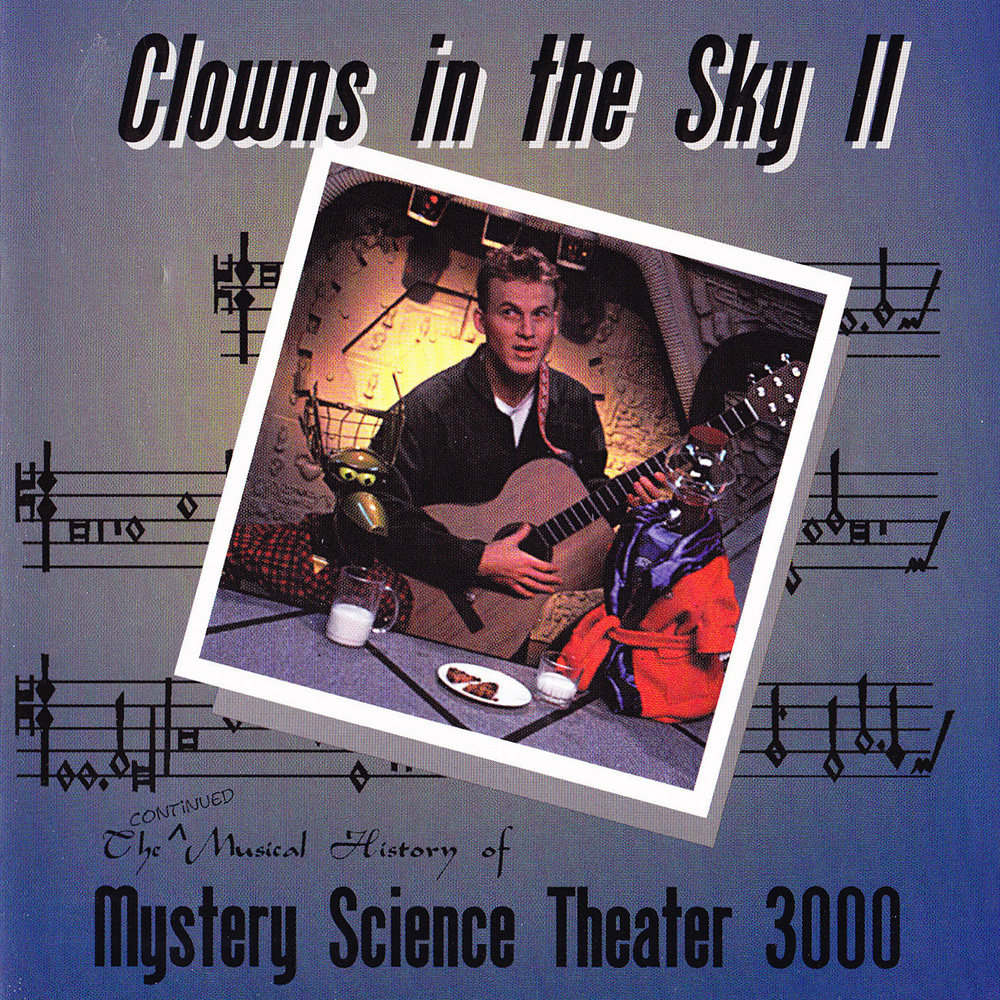
Mystery Science Theater 3000: Clowns In The Sky II
 Sometimes, I think MST3K is not the show it used to be…and sadly, in places, this follow-up to the original MST music collection proves it. Admittedly, not everyone in the cast is musically gifted, and much of the time that’s just part of the humor of the songs that are written by the show’s cast members. And there are some truly nifty musical gems here, such as “Sodium!” (in which, after lamenting that the virtues of sodium aren’t taught in school, Mike and friends launch into a mock-50’s rocker whose lyrics simply consist of the word “sodium” repeated over and over) and “When I Held Your Brain In My Arms” (another 50’s homage, with the brain-toting Observers – actually Kevin “Servo” Murphy overdubbing himself in rather good harmony – doing their doo-wop group schtick). Other extended music/dialogue selections (“Digger Smolken Medley”, “Hobgoblins”, etc.) only work if you’ve seen the shows in question…and it’s pretty safe bet that, if you own this CD or plan to own it, you are indeed a MSTie, so that shouldn’t bother you. Somehow, though, the
Sometimes, I think MST3K is not the show it used to be…and sadly, in places, this follow-up to the original MST music collection proves it. Admittedly, not everyone in the cast is musically gifted, and much of the time that’s just part of the humor of the songs that are written by the show’s cast members. And there are some truly nifty musical gems here, such as “Sodium!” (in which, after lamenting that the virtues of sodium aren’t taught in school, Mike and friends launch into a mock-50’s rocker whose lyrics simply consist of the word “sodium” repeated over and over) and “When I Held Your Brain In My Arms” (another 50’s homage, with the brain-toting Observers – actually Kevin “Servo” Murphy overdubbing himself in rather good harmony – doing their doo-wop group schtick). Other extended music/dialogue selections (“Digger Smolken Medley”, “Hobgoblins”, etc.) only work if you’ve seen the shows in question…and it’s pretty safe bet that, if you own this CD or plan to own it, you are indeed a MSTie, so that shouldn’t bother you. Somehow, though, the  innocence of this show is fading into memory – much of the humor in Joel Hodgson’s era as MST’s host was cute and user-friendly, and this is giving way to a more cynical, mean-spirited style of humor. One need only listen to “The Canada Song” to figure this out. But that’s more a criticism of the show’s overall tone. If you’re a MSTie, you’ll probably like this album.
innocence of this show is fading into memory – much of the humor in Joel Hodgson’s era as MST’s host was cute and user-friendly, and this is giving way to a more cynical, mean-spirited style of humor. One need only listen to “The Canada Song” to figure this out. But that’s more a criticism of the show’s overall tone. If you’re a MSTie, you’ll probably like this album.
- MST 3000 theme: Season 8-9 version with Pearl Forrester (1:25)
- Satellite Hootenanny (1:48)
- Digger Smolken Medley (2:44)
- When I Held Your Brain In My Arms (2:39)
- 1997 Summer Blockbuster Review theme (1:01)
- The Funky 70’s (1:47)
- Sodium! (1:17)
- Loving Lovers Love (2:12)
- Where Oh Werewolf (1:38)
- 1998 Academy Of Robots Choice Awards Special theme (1:11)
- Stay! (1:50)
- Hobgoblins (1:05)
- 1998 Summer Blockbuster Review theme (1:16)
- The Canada Song (2:16)
- Air On A Delta Knight (1:23)
- Mystery Science Theater 3000 Love Theme (1:02)
Released by: Best Brains
Release date: 1998
Total running time: 27:24
Tim Russ – Only A Dream In Rio
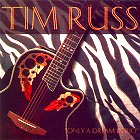 This short CD released by Tim Russ, best known as Star Trek: Voyager’s Tuvok, consists of covers of four songs by songwriters as diverse as Billy Joel (“Rosalinda’s Eyes”), Mark Knopfler (a bitingly sarcastic ode to Mrs. Marcos, “Imelda”), Randy Newman (“Louisiana, 1927”) and James Taylor (the title track, “Only A Dream In Rio”). The four songs’ style is dictated mainly by the first track, a sort of James Taylor-esque light jazz/folk style. The CD’s very sparing packaging only identifies Russ as the lead vocalist and lists a backup singer and a sax player, so I’m not sure if I’d be accurate in praising Russ for the simple but enjoyable instrumental work that backs up his singing, but his vocals are enjoyable. One has no doubt, while listening, to whom the voice belongs, but Tim Russ can change his style to fit the song, whether he effectively emulates the growly delivery of Dire Straits’ Knopfler on “Imelda”, or Newman’s own brand of folksy soul.
This short CD released by Tim Russ, best known as Star Trek: Voyager’s Tuvok, consists of covers of four songs by songwriters as diverse as Billy Joel (“Rosalinda’s Eyes”), Mark Knopfler (a bitingly sarcastic ode to Mrs. Marcos, “Imelda”), Randy Newman (“Louisiana, 1927”) and James Taylor (the title track, “Only A Dream In Rio”). The four songs’ style is dictated mainly by the first track, a sort of James Taylor-esque light jazz/folk style. The CD’s very sparing packaging only identifies Russ as the lead vocalist and lists a backup singer and a sax player, so I’m not sure if I’d be accurate in praising Russ for the simple but enjoyable instrumental work that backs up his singing, but his vocals are enjoyable. One has no doubt, while listening, to whom the voice belongs, but Tim Russ can change his style to fit the song, whether he effectively emulates the growly delivery of Dire Straits’ Knopfler on “Imelda”, or Newman’s own brand of folksy soul.
 Russ’ CD was available through a special offer on the official Star Trek web site, and is probably available through the actor’s official fan club as well. I heartily recommend this one for his dedicated fans, and I have to thank Tim Russ for proving, like Brent Spiner did several years ago, that there are, in fact, members of the cast of Star Trek who can sing after all.
Russ’ CD was available through a special offer on the official Star Trek web site, and is probably available through the actor’s official fan club as well. I heartily recommend this one for his dedicated fans, and I have to thank Tim Russ for proving, like Brent Spiner did several years ago, that there are, in fact, members of the cast of Star Trek who can sing after all.
- Only A Dream In Rio (3:48)
- Imelda (3:31)
- Louisiana 1927 (2:55)
- Rosalinda’s Eyes (2:59)
Released by: The Tim Russ Fan Club
Release date: 1998
Total running time: 13:16
